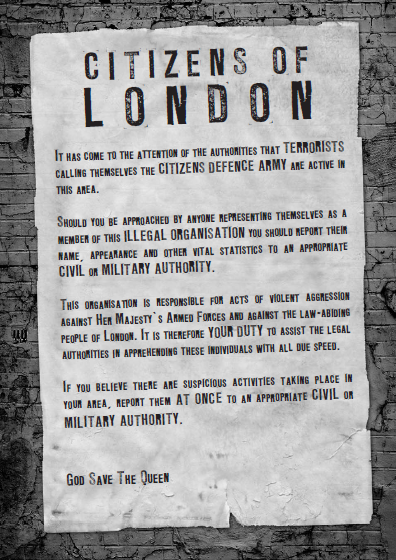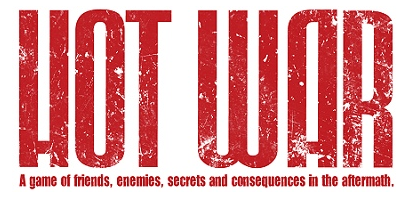Cold City by Hostile V
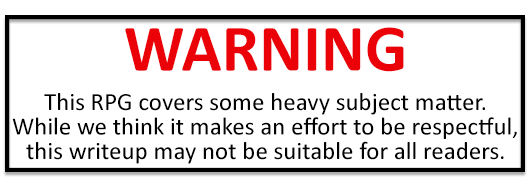
INTRODUCTION & CHAPTER ONE
Original SA post INTRODUCTION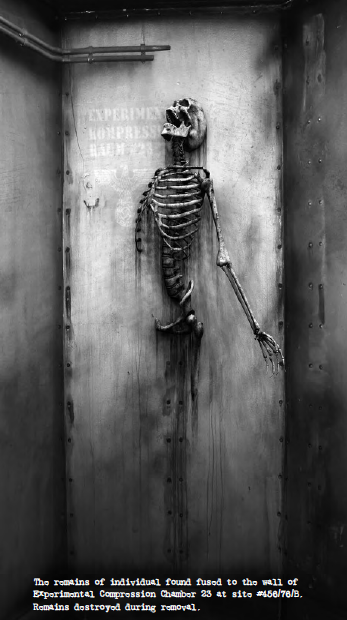
The year is 1950 and the place is Berlin. World War II has been over for five years. Europe is rebuilding with the help of the Allies: Britain, France, America and the USSR. Britain and France are mostly focused on fixing their own infrastructure from the bombings and occupations, so the lion's share of work belongs to America and Russia. Now that the threat of the Axis is gone, the two nations no longer have to pretend they get along; the Cold War is in the first few years of its infancy. The Marshall Plan is a few years in and there's an East and West Germany, but it will be eleven years before the Wall is built.
The war was not exactly the war we knew and rebuilding Germany is not the same as it was in our time. They're 90% similar, but that remaining 10% is the killer. Five years after the war, the aftermath is not entirely dealt with in Berlin. The Nazis had experiments, horrible experiments, that only saw the light of day in the death throes of the Third Reich. Their use and deployment didn't mean a damn thing, the war played out exactly as it normally did and barely anyone noticed something different. But now Russia, America, Britain and France have inherited a half-sealed box of things they don't entirely comprehend. The question is what to do with it.
Everyone has their own answer, their own agenda. For the good of the public, and to keep it quiet and help continue rebuilding Berlin and Germany, the four nations (and the new German government) have assembled a task force to operate in the shadows of reconstruction. They are the Reserve Police Agency and their job is to contain the horrors, protect the populace and dismantle anything the Nazis left behind that might still be in operation.
And if it should end up extracted during PAPERCLIP, or end up in a French laboratory, or on a workbench in Sheffield or a Russian ZATO, well. Sometimes things get lost or moved when you clean house.
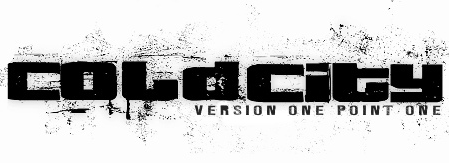
Hi and welcome to Cold City! Cold City is a game about hunting monsters, espionage, betrayal and learning to trust strangers. The creators of the game themselves describe the core content as a mix of Hellboy, The Third Man and The Manchurian Candidate. The surface conflict is RPA officers versus the remnants of sinister Nazi experiments and things beyond space and time. Beneath that, the conflict is a lot more human. The central conflict of the game is one of Tension and Trust: tension between you and your government, between you and your duties, between you and the locals of this city you're trying to fix, between you and your teammates, between what you can do and doing the right thing.
I like this game quite a bit! It's pretty rules light and it's rather aware of the sensitivity of its subject matter. I'll be including art when it appears (most of it is in the cryptic "you can use this as a plot idea!) sense but here's one thing I won't really be including: the in-character documents. This game (and its sister game, who I'd like to cover when this one is done) has some quite excellent documents that help set the tone and build the world. The documents are a lot more necessary to the sister game, but I feel like I can't give you everything Cold City offers because I do sincerely think this game is worth buying or picking up in a bundle. It's a ten dollar game and it's a good ten dollar game.
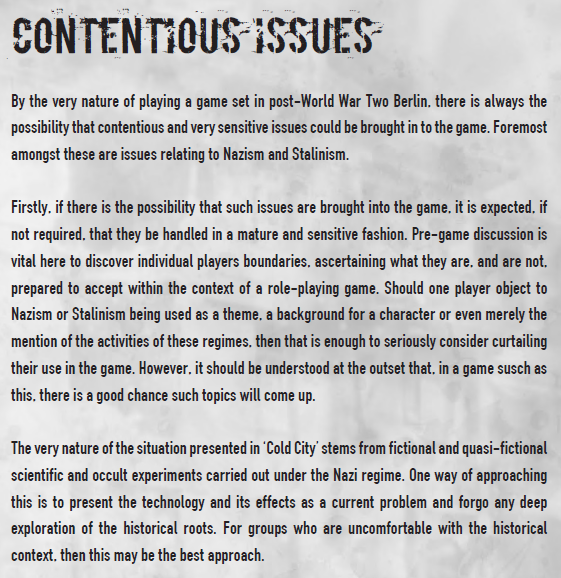
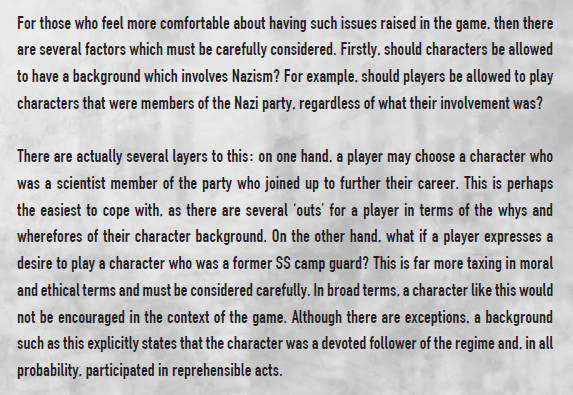
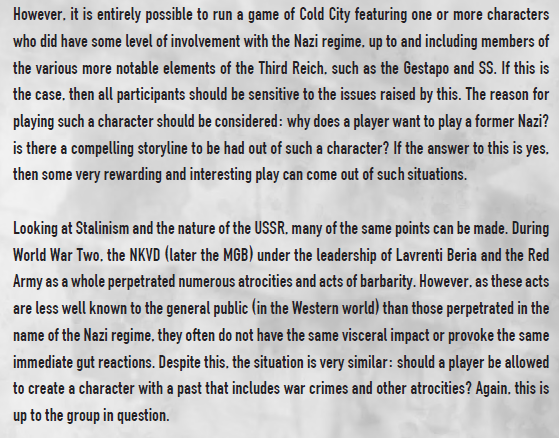
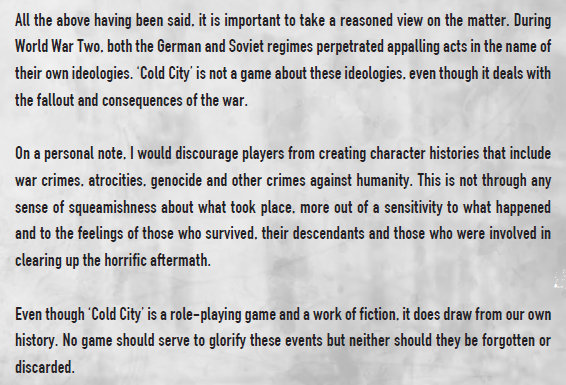
CHAPTER ONE
Let's get to the elephant in the room: what did the Nazis do in World War II?
In a nutshell, the scientists of the Third Reich did find...something. That other 10%. It wasn't a perfect Aryan race, or the Spear of Destiny, or a book clad in human skin. What the Nazis came up with was called Twisted Technology, machines that grabbed reality and squeezed until things happened that shouldn't. Twisted Technology only exists because it's a conglomeration of three things: technology, occultism and needless, cruel suffering. Most of the scientists involved are dead or in government captivity and each have their own story to tell. Some of them ignore the occult trappings, the rituals, the invocations of power. Some ignore the machinery, the chemicals, the experimental serums and radio emitters. Ultimately, Twisted Technology that still exists in Berlin comes down to three categories:
Die Veranderten: The Alternatives. The Alternatives are people who were subjected to experiments and rites and managed to survive intact. A lot of them are mentally impaired or damaged as a result of what happened to them, possessing abilities beyond human capability.
Die Eindringlinge: The Incursors. The Incursors are things not of our world or our time, dragged from their realms or invoked by Twisted Technology. Some of them are now trapped in our world or the machinery simply acts as a key to a door.
The Dead: The Spezialeinsatztruppen (Special Purpose Troops, STs for short) are re-animated corpses, sometimes soldiers, sometimes civilians killed in bombing raids. To be undead is to exist in a state of constant suffering.
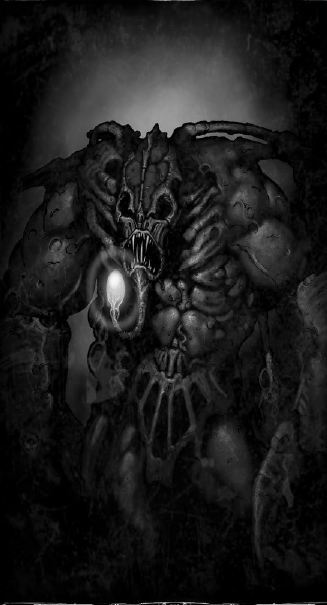
Whatever this thing is, it could either be a category one or a category two.
All three categories still exist in Berlin in one form or another, haunting the shadows and sewers and abandoned facilities. Dealing with them falls to the RPA. The Americans are officially busy with Paperclip and Alsos, relocating German scientists and securing German atomic/chemical/rocketry research respectively. Soviet agents are doing the same thing. Beneath the veneer of official business are the national initiatives to seize Twisted Technology. Operation Strangle is a joint initiative between Britain and the USA while Projekt-303 is the Soviet equivalent. Unfortunately, a lot of these initiatives trickle down through the RPA.
The Reserve Police Agency is a complete misnomer to throw off anyone poking around. They are neither reserve or a real police agency. Founded in 1945 and funded by all four countries rebuilding Germany, the RPA has a couple hundred operatives of various nationalities and backgrounds. Agents travel in groups of three or four and new agents have to learn to work with their allies and stand up to the monsters in the darkness.
The RPA isn't corrupt, but it is suspicious. Agents of different countries might not trust each other or turn on their own country. The RPA as a whole does not officially condone agents operating for their own country's benefits but that just inspires caution and care when doing it. The big question is who you're loyal to.
Powers of the RPA:
- You can't really arrest people. Ordinary criminal activity should be turned over to the military police to deal with.
- Agents can carry and use unconcealed and concealed weaponry. Kill or hurt innocent bystanders, though, and you're looking at an assault or murder charge.
- Secure and neutralize Twisted Technology in any form for containment.
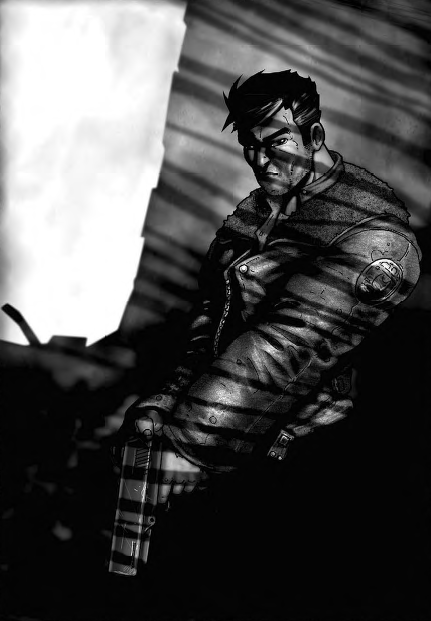
NATIONAL INTERESTS
Britain lost its empire in the war and had to deal with the German bombing campaign targeting industry and infrastructure. Britain's interests in Twisted Technology are twofold: prevent it from being used in a military capacity, disassemble it to understand it and attempt to adapt it for peaceful purposes. Porton Down is the big facility investigating what the British government can find and its scientists are performing experiments, toeing the line between caution and exploration.
France doesn't really care much for Twisted Technology. They're helping in Germany over a sense of duty and obligation and this extends to the RPA. The sooner it all gets cleared and settled, the sooner it's over.
Germany backs the RPA wholeheartedly to put the last of the ghosts of Nazi Germany to rest. They fear that public knowledge of Twisted Technology will result in Germany's political death, so the best way to do that is to help the RPA.
America wants to profit from the rebuilding of Germany and Twisted Technology is part of it. The US Army has never seen anything like it before and are taking as much of it as they can to reverse-engineer and experiment. There's probably peaceful applications but for now an edge over the USSR is appealing.
Russia wants its own edge and the Stalin regime is more than willing to experiment and explore the "science" behind Twisted Technology. Projekt-303 has full Kremlin backing and want to add weaponized Twisted Technology to their atomic arsenal.
NEXT TIME: character creation in Chapter 2.
CHAPTER TWO
Original SA post
CHAPTER TWO
Game and Character Creation
Cold City values the idea of building the game and campaign with the players before making characters. You want to figure out how long you’d want to play for, what kind of tone you’d like and if you want a closed game or open game.
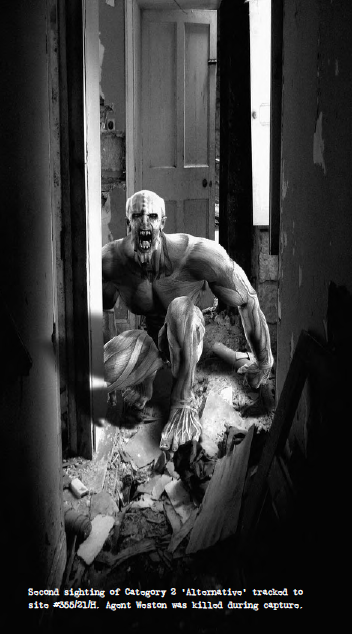
Closed Game: The players don’t know each other’s Hidden Agendas for any characters but their own. Character creation is a group process up until you get to Hidden Agendas and then the players step aside to talk to the GM. The upside of a closed game is that it heightens the drama and the tension. The downside is apparent to anyone who has played a game of Paranoia: it puts a lot of weight on the GM and might lead to some friction at the table.
Open Game: The players know each other’s Hidden Agendas, character creation is an open process. An open game is less dramatic and much more of a group story; use the knowledge of what everyone wants to move the story along without focusing on just one Agenda. Honestly the open game feels like the better choice for Cold City, but that’s my opinion.
SAMPLE GAME TONES
- Pulp: Light-hearted take on the game, focusing on two-fisted action and monsters and theatrical villains. The consequences of Nazi experiments and Twisted Technology are treated more as serial-style Mad Science, focusing less on the darker aspect of Twisted Technology and more on stopping it and protecting people. Inspirations: Hellboy, Sky Captain and the World of Tomorrow.
- Noir: Shades of grey and spies in the shadows. Fear, mistrust, backstabbing and maneuvering are punctuated with gunshots and brawls. The villains may be a reflection of the interest of the protagonists. Inspirations: Kiss Me Deadly, The Third Man.
- Arthouse: Focus on the psyche of the characters and their internal struggles. Deal with matters of society, sexuality, ethics, and personal crises and run the risk of not finding any answers when the campaign is done. This type of play requires introspection and self-analysis of the characters and what they want and what they believe. Inspirations: Europa, Kanal.
- Dark Horror: Emphasize the amoral nature of the people who took part in the atrocities and focus on the horrific nature of Twisted Technology. Do not be exploitative, that would be reductive towards things that actually happened. You can keep the horror simple and personal: focus on the threats towards people you know and care about, like lost soldiers from your unit or the family down the block. Inspiration: Come and See, Jacob’s Ladder.
- Black Comedy: You’re trapped in an international bureaucracy and the Cold War is only ramping up from here. Focus more on the Cold War aspects and the fact that the characters have limited influence and control over what they can do. Be careful with how you’d use Nazi atrocities and experimentation in the sense of Black Comedy. Inspiration: Catch-22, Dr. Strangelove.
- Ask the players the following question: ”What are we doing?” What would you like to see happen and what should the GM bring to the table?
- Ask the players ”Who are the antagonists?” This can be a snippet of an idea or a somewhat detailed image. It also doesn’t have to be a person or a group; it can be a piece of Twisted Technology or a monster.
- ”Who else features in the game?” Are there any groups or people that are important to the characters that should factor into the story?
- ”Are there any scenes the players want to see?” Ask for at least one scene in the form of a snippet or a brief collection of sentences. The players can collaborate on the scenes but the GM should be allowed to build on them or figure out the context of the scene within the mission.
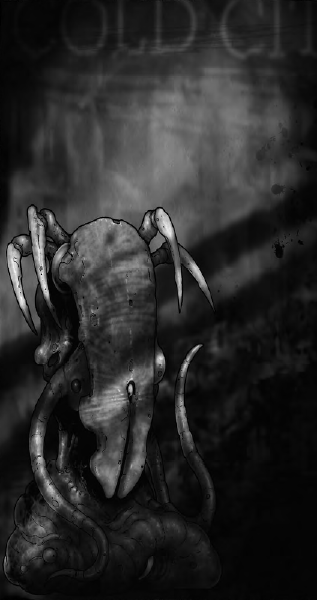
CHARACTER CREATION
- First, pick a Nationality. No two players should have the same nationality. The common nationalities are American, British, French and Russian. On occasion you might be from a less invested nation who is here for business besides rebuilding (Polish, Austrian) or a German citizen.
- Second, pick a Name.
- Third, pick an Occupation and Background. A military background isn’t uncommon, but you can choose any background you want like Black Market Salesman, Soviet Political Officer or Jewish Historian.
- Fouth, pick a Draw which is why your character got drawn into the RPA. This should be pretty brief because later you’ll get to play the scene, something like “asked too many questions emptying out a German warehouse” or “realized that the soldiers on the enemy side were the walking dead”.
- Fifth, assign Attribute Points. There are only three Attributes that start at 1 and you have 5 points to spread across them. The Attributes are Action (any physical action), Influence (raw charisma or use of interpersonal skills) and Reason (solving problems with thought).
- Sixth, pick Traits. Traits can be positive or negative and add personality to your characters. They also add 1 dice to rolls when you use an applicable Trait. You can start play with up to 5 Traits but two must be negative. There’s more to Traits but here’s what I love about this system: a negative Trait is not a bad thing, it just might have some “you succeed, but” issues if it’s the decider in a roll. Sample Traits: Distrusts Authority, Smooth Talker, Total Egghead, Argues Angrily, Military Reputation. You can only have 9 Traits at a time, max.
- Seventh, pick Hidden Agendas. Agendas break down into National and Personal, or what your country wants you to do while in the RPA and what your character wants to do or achieve. You need to have one National Agenda and one Personal Agenda. Sample National Agendas: secure Twisted Technology for American research, kill monsters in Berlin to stop the German people from ever realizing the truth, influence the RPA to have more of a Communist influence. Sample Personal Agendas: get the German woman you love out of East Germany and to the safety of Britain, sell Twisted Technology on the black market, find dirt to out Corporal So-and-So as a Communist spy.
- Eighth, write down your Languages. Everyone knows how to speak German for the purposes of business and you also know your national tongue. So Americans speak German and English, French speak French and German, Russians speak German and Russian.
- Ninth, divide Trust to determine your relationships with the other characters. The Trust you have to dole out is equal to (number of characters-1)x2. You have to figure out one reason why you trust them for each point of Trust. When you assign Trust, tell the other players your levels of Trust in them.
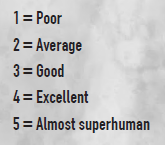
TRUST
Initially, your views on other characters and nationalities should have a little bit of stereotype to them before you open your mind and learn to get past them. The stereotypes are based on national views and propaganda that the characters have been exposed to and should lightly inform how they view the other characters at first. Pick one or two of the following stereotypes:
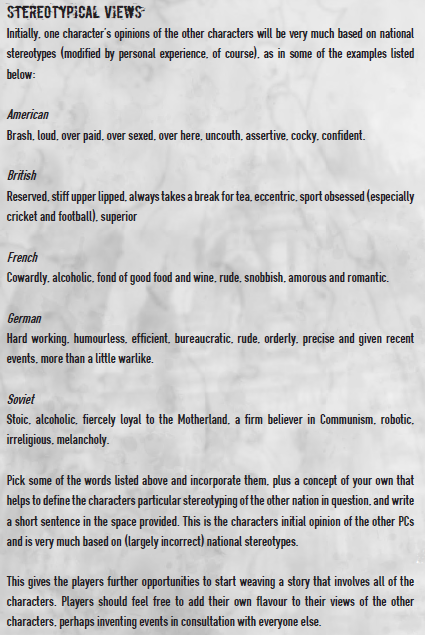
As the game goes on and as the characters learn to Trust each other, you can start leveraging Trust and start ignoring the stereotypes. Trust can be used in two ways. First, in a conflict where you are trusting another character to help you, add your level of Trust you feel towards them as bonus dice. If you have Trust 3 towards someone else, you get those three dice. Second, if you're betraying someone you can add the Trust they feel towards you as bonus dice. This is cumulative if you're betraying multiple people. At the end of combat, you can raise the Trust in another character by 1 or lower the Trust by any amount.
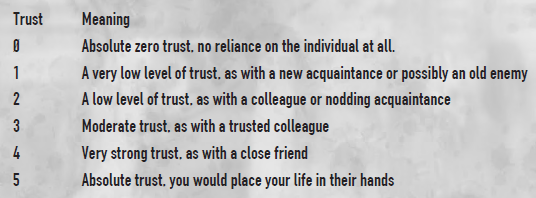
THE DRAW SCENE
So before you play the game, you get to play out the Draw that you figured out for your character. This is a lot like what you see in any nWoD game, but the other players actually get to play a part in this. The player gets to pick out what the scene would be with three restrictions. 1: The scene must include the Draw by taking place when the Draw is set, the direct aftermath or right before they join the RPA. 2: There must be conflict in the scene. 3: The stakes for the character must not result in the character being killed or prevented from joining the RPA.
The player of the character can draw the scene and the opposition/conflict of the draw has a dice pool of 5d10. The other players around the table can reduce or increase the opposition pool by 1 dice per person for whatever reason they see fit, thinking success/failure would be a better story or for liking the roleplaying or for whatever meaning. Winning the conflict of the Draw grants you a free positive Trait based on the conflict, losing gives you a relevant negative Trait.
And that's it for chapter 2! The system is pretty light but I like the Trait system quite a bit and like I said, it's good to ask players what they want to play and what they want to do when you're coming up with a campaign. Next time we'll check out Chapter 3, playing the game and mechanics.
CHAPTER THREE
Original SA post
CHAPTER THREE
Playing Cold City
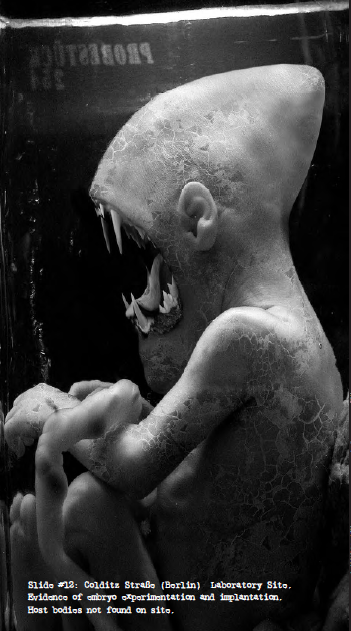
To directly steal some of the words from this chapter, today we’re going to learn how to frame a scene and how to resolve it.
SCENES are made up of four things: place, people, context and conflict. It’s predominantly a GM’s job to frame a scene while it’s the job of the players to say what they’re doing and how they’re affecting the world. Scenes should be separate and distinct while the players should feel free to tease the senses with sights, smells, sounds, etc. Anyone has the power to call an end to a scene and the fact that at least one person feels that way is an indicator it’s time to move on. The GM and the players should also bring their Hidden Agendas into play at least once a session depending on if it’s an open or closed game. Even another player can feel free to add a little spice to a scene to give another player an in for an agenda.
CONFLICT is tricky and at least one conflict should happen per scene. Rule of thumb is that the characters should automatically succeed (or at the very least “yes, but”) if it would move the story forward unless it’s an important conflict or a vital situation. The specific example the book mentions is “the characters are being chased by a monster and have to climb a wall to escape. They should succeed the climb because otherwise it would bring the story to a screeching, inglorious halt”. The game defines a conflict as “at least two entities with different desires and willing to face off over it”.
To start a conflict, bring your d10s and state what you want to achieve if your character wins the conflict. Pick a reasonable Attribute (Action, Influence, Reason) for a starter pool of dice. If this conflict allows you to bring a Hidden Agenda into play, double that base pool of dice selected from an Attribute. You can also pick relevant positive or negative Traits to add one dice to the pool per trait, these Traits changing how your character goes about resolving the conflict and should be incorporated into roleplay. If this is a negative Trait, it should be a different colored die or rolled separate if it’s an online roller. You can also bring a Tool into play, something your character has that is relevant to how you’re trying to go about things (a gun pressed into someone’s back, bribe money, bouquet of flowers) for two dice. One player can use one Tool at a time. Finally, you can add Trust to the dice pool depending on if you’re betraying someone or leaning on their Trust. As you can imagine, this can create quite a large pool of dice to throw around. On the other hand, circumstances might take away dice to represent negative circumstances.
The opponent can be a premade NPC that the GM made, another player or a set pool of dice set to represent the opposition. Opposition can be a person or a monster or even an environment. Once both sides have their pools of dice put together, then you roll!
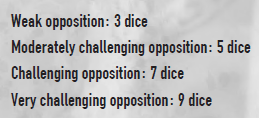
Conflict resolution is simple: the pool of dice with the highest number wins, no matter how big or how small the pool is. If it’s a tie, both numbers are removed from the board and you move onto the next highest (both sides have a 10? Remove the 10s and look at the next highest). That’s all there is to it.
If people on one side team up, one character can be designated as the main actor while the other assistants can add relevant Attributes and Traits as dice to help the main actor. If there are just multiple sides fighting in a conflict, only the person with the highest result can win.
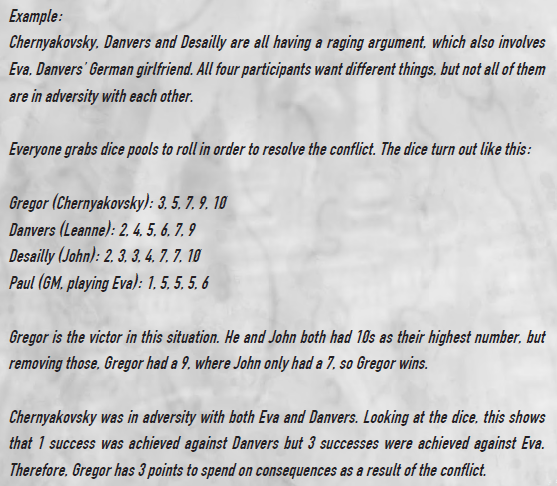
CONSEQUENCES
When you win a conflict, you get points depending on the difference between your highest number and the opponent’s. These points can be spent in different ways for yourself or for others. If Greg has a 9 and John has a 4, Greg has 5 points to spend on doling out consequences in addition to getting what he wants from the conflict. Consequences have to logically stem from the conflict and what the sides were trying to do.
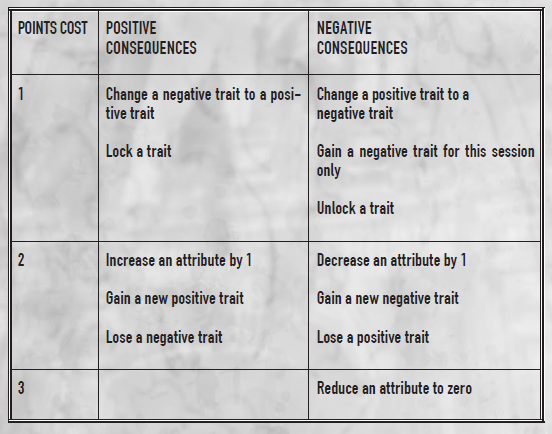
Increase/Decrease Attribute: The max level for an Attribute is 5 and the Attribute can only be increased by 1 at a time (so if Greg uses that 5 points, he can’t increase an Attribute by 2). Decreasing an Attribute can be roleplayed as a wound, a blistering argument or a disorienting assault on the senses or however you see fit in addition to beating the opponent.
Gain new Positive/Negative Trait: The new Trait should reflect the nature of the conflict. You can have max 9 Traits total.
Gain Temporary Negative Trait: Lasts for the rest of the scene or the session and then goes away.
Change Trait to Positive or Negative: Put a positive spin on it and make it easier to use that Trait without consequences or vice-versa.
Lose Positive/Negative Trait: Perhaps you’re improving yourself or perhaps you’ve lost something. Characters change and grow and Traits are not set in stone.
Lock Positive/Negative Trait: Locking a Trait means it can be used in a conflict without being removed or flipped from good to bad or bad to good. There’s no limit to locking Traits but keep in mind that Traits are part of your character’s identity and too many locked Traits is somewhat stagnant.
Unlock Trait: Reverse a lock and put a Trait up for danger if it’s used again.
Reduce an Attribute to 0: Doing this immediately removes the character from active play and triggers a Crisis Point.
The winner also gets to narrate the results of the conflict (with the help of the other participants setting the scene and adding actions). If the winner is a player, they can’t make statements of fact about things they’ve found or discovered. The GM can’t make statements of fact about player characters and the players can’t make statements of fact about the NPCs.
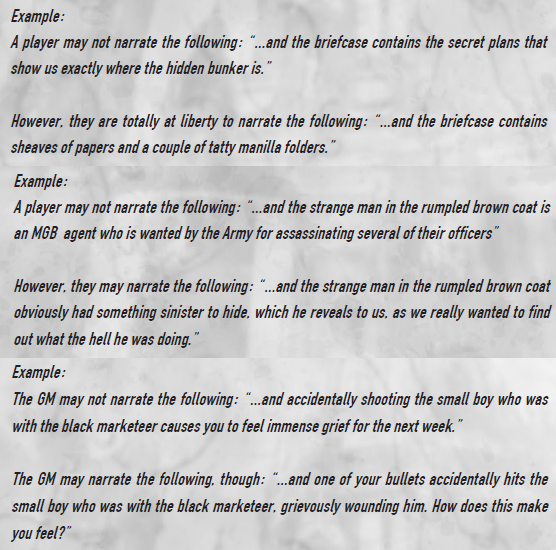
Also from here you should change Trust as you feel appropriate.
Additional Rule: Remember how I said that a negative Trait should be rolled separate somehow? If the negative Trait is the one that wins the conflict, turn the success into a “yes, but”. “Yes you win but you make an absolute ass of yourself”.
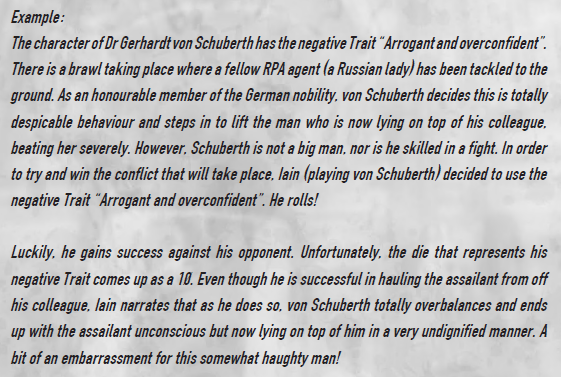
CRISIS POINTS
A Crisis Point is a moment where a character is in extreme peril or danger because an Attribute has dropped to 0. 0 Action might mean that the character is gravely wounded, 0 Influence might be madness or immense disgrace, 0 Insight might be a complete loss of senses and reasoning. There might very well be death or permanent insanity if the player thinks it’s appropriate.
If a character has hit a Crisis Point, they have to resolve it. Until it’s resolved, they can’t act in scenes in conflicts but they can be around in the background doing other things. If the player wants the character to die, the next scene should be an epilogue narrated by the player that concludes this character’s story. If the player wants the character to return, there needs to be a scene inserted where the character recovers. This scene is also narrated by the player. Choosing to come back isn’t a slap on the wrist, though: you regain the Attribute you lost at half the original level (round down, minimum one), lose a positive Trait appropriate to the conflict and gain a new negative Trait. NPCs do not get Crisis Points: they are either permanently removed from play or may return next session with half the Attribute and a loss of a positive Trait.
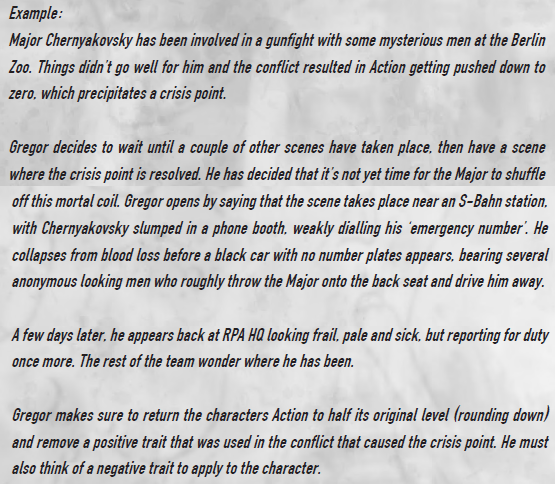
MAKING NPCS
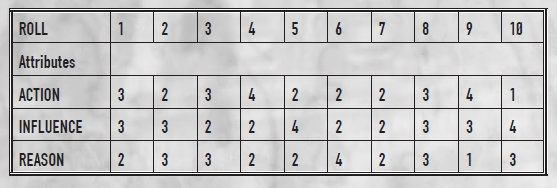
Making a quick NPC is easy. Roll 1d10, take the result from the table above, give them two positive and one negative Traits and give them one Hidden Agenda (either Personal or National). Included are the sample NPCs the book provides.
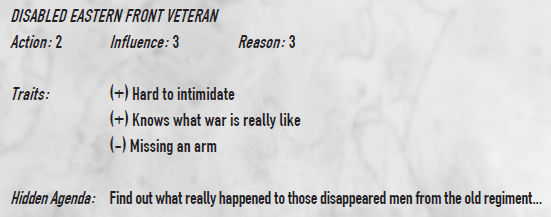
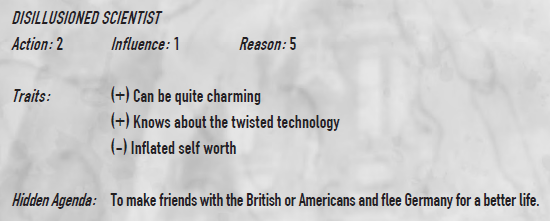
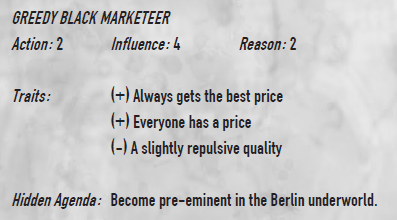
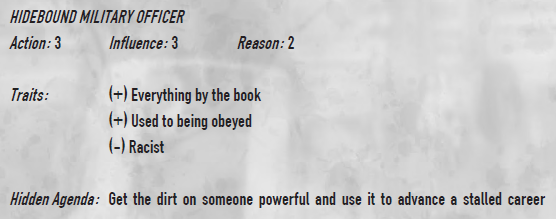
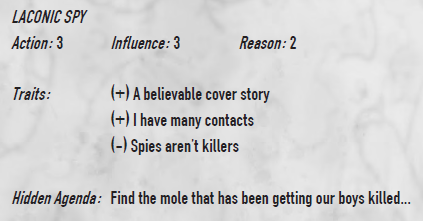

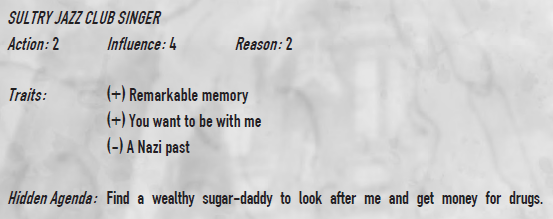
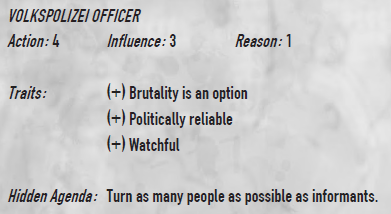
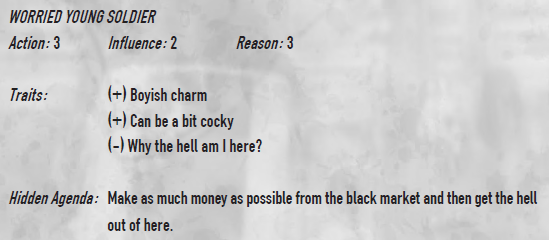
Making a notable NPC is different. Notable NPCs get 8-14 points to spend on their Attributes with the rule of thumb being the higher the pool the more monstrous the NPC is. They also get three positive and two negative Traits, Hidden Agendas if appropriate and Trust if appropriate.
And that’s all you need for mechanics to play Cold City. It’s simple, it’s quick and I like it quite a bit. I like how there’s no real measurement for health and that you can alter what your character can do pretty easily if you do well. It’s not hard to amass a good pool for a conflict.
NEXT TIME: the world of 1950s Berlin, organizations, NPCS, missions and more.
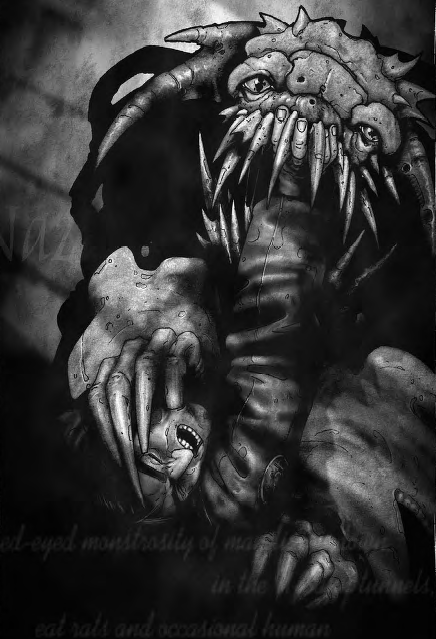
CHAPTER FOUR, PART ONE
Original SA post
CHAPTER FOUR, PART ONE
BERLIN, 1950
The river Spree runs through the ruined city. Restoration and rebuilding are the big industries of Berlin and the citizens are trying to keep their heads up and keep things together. A lot of apartments are occupied again at the cost of abandoned homes, office buildings and local businesses remaining empty or destroyed. The roads are being rebuilt but the U-Bahn (underground rails) and the S-Bahn (aboveground) are open for mass transit, shipping and travel. However, the U-Bahn is not a safe place to be on foot. The sewers and tunnels are inhabited by all sorts of beings left over from experiments and theirs is a desperate existence of hunger and hiding.
The East and the West haven’t been divided by the Wall yet but there’s a cultural wall. West Berlin uses the Deutsche Mark, East uses the Ostmark. Going East requires you to exchange currency 1:1 despite the fact that on the black market 5-10 Ostmarks go for 1 Deutsche Mark. The East is Communist, industrial, controlled by the USSR. The West is being rebuilt by the Allies and is working towards a capitalist system. Every day the halves of the city diverge more and more.
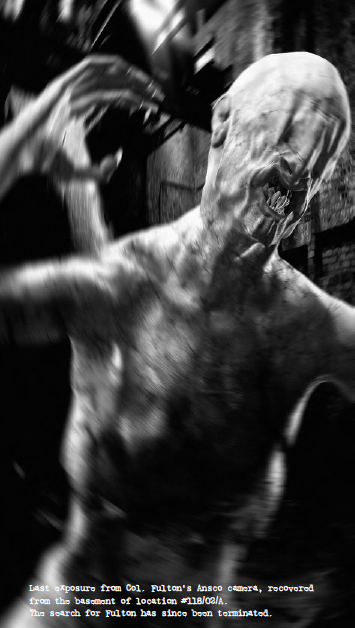
Berlin, Underground
There are two undergrounds: the black market and the literal underground. Both are home to things hiding after the war. A lot of people who work in the black market are ordinary people driven to survive, selling old surplus stock and information for food and money. The information trade is quickly growing to be the big business as the lines are drawn for the Cold War. Alternately, the underground is a collection of abandoned army bases, sewer tunnels, bomb shelters. The two overlap, with monsters living underground in the same places that regular citizens plunder lost goods from.
Notable Places
The Anhalter Bahnhof: The AB Station is an abandoned railway station left to rot after a nasty bombing campaign left it ruined. It’s left to the Alternatives, STs and Incursors and openly rotting and collapsing. There’s a lot of open water accumulating only exacerbating the growing sinkholes and collapsing masonry. There is, however, a big draw to the area: an abandoned, sealed air-raid shelter that nobody has entered yet.
The Flak Towers: Three flak towers were built for the war in Tiergarten-Zoo, Freidrichshain and Humbolthain. Only the Humbolthain tower is still standing; all of them are partially destroyed and collapsed but Humbolthain the least. The STs are drawn to the ruins for reasons unknown.
RPA HQ: RPA HQ is in the Kammergericht which was theoretically left empty after Russia left the Allies to run East Berlin. The Berlin Safety Air Center takes up less than 10% of the building and the rest is abandoned…except for the basement. The basement is home to the RPA, heavily secured and packing enough space for the force and some offices too. They’re a bit cramped, but they’re just enough out of the way to hide their activities.
Spandau Prison: Originally built for hundreds, Spandau Prison is home to just seven prisoners now. They’re all high-ranking members of the Third Reich: Donitz, Funk, Hess, Speer, Raeder, von Neurath and von Schirach. The four major nations each spend three months controlling the prison and watching the prisoners. It’s not a hard job (there are four fences keeping the prisoners in and machine gun towers manned 24/7) because these are bunch of bad men rendered somewhat harmless by the nature of their captivity. This doesn’t stop the prison from being a magnet for strangeness. The RPA has interrogated the prisoners about odd topics in the past and they’ve been known to venture into the tunnels beneath the prison to explore. There are also rumors of an eighth prisoner.
The Virus House: First the Kaiser Wilhelm Institut, now the Max Planck Institut, the Virus House is where Nazi Germany tried to crack the secrets of the atom. This didn’t pan out, but the projects much weirder than the atom bomb paid off for Germany in the facility’s secret testing zones. The Virus House was a major fixture of the Nazi’s production of Twisted Technology; a lot of experiments on reanimating the dead were performed here and so were most of the tests for the machines that summoned Incursors. Most of them no longer remain, not since the Red Army occupied the facility in 1945 and ransacked the building for technology and data. But there are still things that remain in the place that made them, creatures and beings that need to be dealt with or laid to rest.
NOTABLE ORGANIZATIONS
Intelligence Organizations
British Experimental Rocket Bureau: The BERB are run by a man who calls himself The Professor, so you know they’re a sane bunch. They operate out of Porton Down and Spadeadam with their main headquarters in Porton Down. So why are a bunch of non-military British rocket scientists here in Berlin? They’re friendly with the British military and as a result they have first dibs for analyzing recovered Twisted Technology and as a result some RPA agents report directly to them. The British government keeps BERB’s research out of the public eye for two reasons: national security and the fact that they have been experimenting in Britain using Waffen POWs. If this was to get out, there would be major consequences for England.

Central Intelligence Agency: The Company is in its infancy and its main job is to counter Soviet activities in Germany. They’re working on starting the great American spy ring in Europe and to that end they’re funding the Gehlen Org (see below). From what they’ve heard of Twisted Technology and the RPA, they believe that the RPA should be subverted to frustrate acquisition efforts for every country that isn’t named America. They’re not fond of the other American presence in Germany, the USAF’s 515, considering them to be idiot amateur spies.

Gehlen Org: Reinhard Gehlen was the former chief of the Wehrmacht’s intelligence efforts. Now he runs Gehlen Org, a spy ring dedicated to relaying information on Germany back to the Western Allies. Behind the legitimate business ventures funding the whole operation is the fact that a lot of the spies are notorious ex-Gestapo or ex-SS. The main reason they’re allowed to function without facing the music is because they feed East Germany and USSR intelligence back to the CIA and they’re not ready to let them hang yet. They’re interested in the RPA due to Soviet interests. Also, if the RPA fails, they’re top dog and the CIA money will keep flowing.

Gosudarstvennoye Komitet-11: GK-11 (State Committee 11) is a Soviet government agency that doesn’t seem to answer to anyone. They do, in fact, have a boss: Josef Stalin himself and Stalin’s top committee members. GK-11 is responsible for the experimentation by Twisted Technology taken from the GRU and other intelligence groups. As a result, Soviet intel doesn’t really like GK-11 for taking their spoils and gaining praise from results. But they’re incredibly powerful, running multiple top-secret facilities like Pripyat in the Ukraine and Krasnoyarsk-14, a closed city. GK-11 also owns gulags containing extracted Nazi scientists working in labs for them. Rumor has it that GK-11 has also taken Japanese scientists from the notorious (in real life and in-game) Unit 731. The other Soviet intel groups have taken to calling GK-11 “Koschei” as a code name, for good reason.

Glavnoye Razvedyvatel'noye Upravleniye: GRU (Main Intelligence Directorate) is the USSR’s military intelligence group, specifically working to bolster the preparedness of the Russian military. The GRU is famous for infiltrating other groups in their home countries. They believe that Twisted Technology could be a boon for their armed forces, but ever since they set up Projekt-303 and got the lion’s share of all of it for Russia they’ve been ignored for GK-11 and MGB (see below). The GRU might do something ruthless to be the best again.

Ministerstvo Gosudarstvennoi Bezopasnosti: The MGB is the replacement for Russia’s NKGB, acting to collect foreign intelligence, suppression of counter-revolutionaries and spying within the USSR. They’re the boogeyman to the Russian people when they’re not infiltrating foreign governments and trying to stir up Communist sympathizers. The MGB has the most fingers in the pie of the RPA and the GRU and GK-11 hate them for that. Their main goal is to fuck over the involvement of the GRU and GK-11 and make them look bad.

Service de Documentation Exterieure et de Contre-Espionnage Departement B: SDECE-B is a branch out of the SDECE (which focuses on military and civilian intelligence during the war for France). B deals with Twisted Technology and they’re a motley crew. Everyone onboard has had an experience with Twisted Technology, so they recruit POWs and soldiers and spies and Vichy collaborators. They don’t particularly all love each other and they don’t quite agree what to do. Some of the top (especially military) believe that Twisted Technology is the key to French supremacy and stopping this from ever happening again. Others have had more direct experiences with Twisted Technology and want every single piece destroyed. The latter group has been secretly sabotaging French experiments being performed at the ex-concentration camp of Natzweiler-Struthof in the Vosges mountain range.

Secret Intelligence Services: The SIS (MI-6 to others) is mostly made up of Churchill-appointed Special Operation Executive members, previously responsible for sabotaging German efforts during the war. The SOE side of the SIS is tough and resourceful and the group has benefitted from them as a whole. As a result, they firmly believe that Twisted Technology should be catalogued, contained and buried to help protect Britain from future superweapons. They have a less-than-friendly relationship with the BERB, thinking they’re playing with a fire they don’t know enough about. The SIS doesn’t directly work with the RPA as much as other groups, focusing on working without it and directly countering their hated rivals in the MGB.

USAF 515th Intelligence Wing: Located in a shack outside of the Tempelhof Airbase, the 515th is made up of soldiers and scientists who were involved in Strangle, Paperclip and other extraction/recovery efforts. Their main job is to extract the rest of the Twisted Technology from Berlin and interrogate people defecting to the USA. They're starting to have more of an intelligence and espionage focus and that's annoying the CIA who are working on discrediting them. In turn, the 515th is working on actually recovering technology and intel.

Military Organizations
British Army Berlin Brigade: Three battalions that are headquartered at Lancaster House in Wilmersdorff along with a post outside of Spandau Prison. Their main job is to find and recover intel and Twisted Technology and get them back to Britain. They have armor, artillery and air support.

Forces Francais a Berlin: The French Forces in Berlin are in possession of Tegel Airport and Quartier Napoleon. They're infantry with more of a focus on engineers and military police. Their main goal is to destroy Twisted Technology and burn any intelligence or papers on it.

United States Army Berlin Military Post: Centered outside of Tempelhof, the USABMP is also infantry with more of a mix of jobs and groups. Their main job is to observe and analyze the monsters and compile reports.

Police Organizations
Ministry for State Security: The Stasi are young, very young. They were only formed in February of 1950 but they're quickly working on infiltrating everyone and everything in East Berlin. The Stasi is not yet aware about what the RPA is up to and they're chomping at the bit to infiltrate them.

Der Volkspolizei: The VoPos are made up of military vets who are sworn members of The Party in East Berlin, predominantly focusing on actual crime and police duties. They underwent a political purge in 1949 and are thoroughly loyal to the USSR, working closely with the Stasi to stop crimes while the Stasi monitors for trouble.

THE RPA-DC
The Directorate Committee of the RPA is made up of five NPCs, each representing a country with a stake in the RPA. RPA officers get their assignments and duties directly from members of the DC and because everyone on the DC has their own agenda, this can lead to political maneuvering and backstabbing.
Magda Bremmer: Bremmer is the German representative who started off as a translator in 1946 for America in a covert signals division. When her division was responsible for coordinating an extraction of Twisted Technology that resulted in a bunch of American soldiers becoming altered, Magda agreed to keep her mouth shut. Finding her to be loyal and secretive enough, the Americans pushed for Magda to be brought in as an advisor for the RPA representing Germany.
Magda is officially just an advisor but unofficially she's seen enough and done enough to be considered a proper member of the Directorate Committee. All she wants is for Berlin to be rebuilt and for Germany to move on (and for the civilians to not know about the Reich's experiments). She wants to use the RPA to protect the people of Berlin.
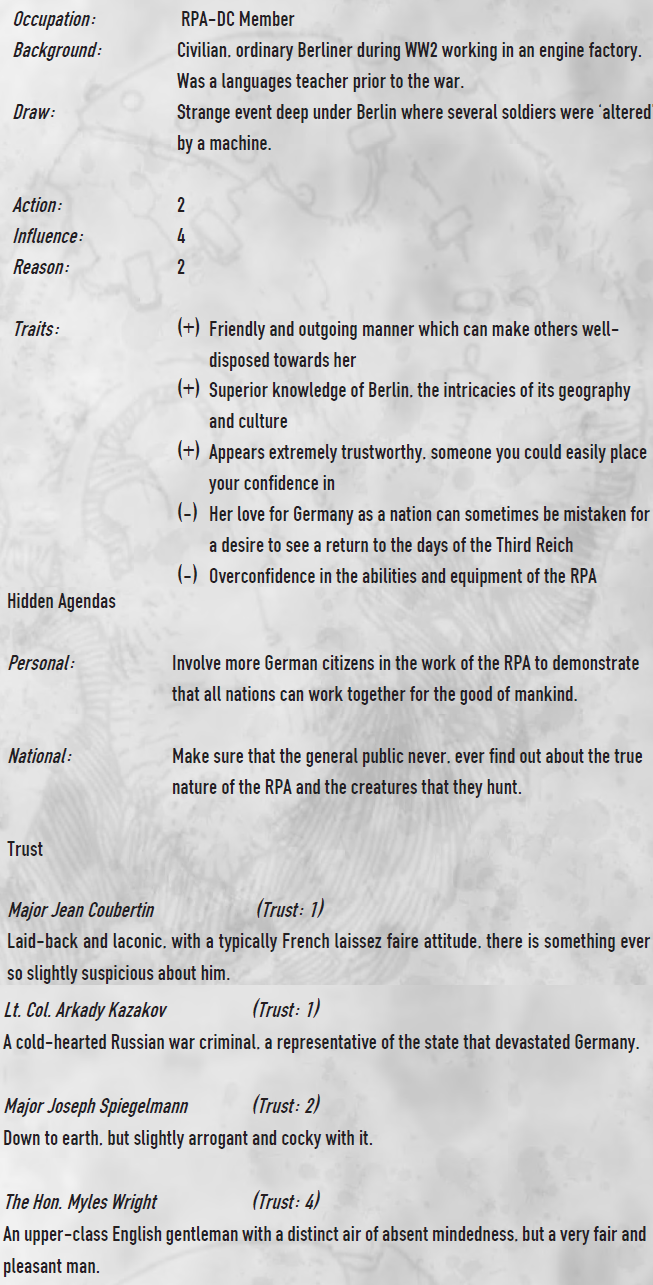
Major Jean Coubertin: Jean is the French representative, a Captain from the French army who came from Breton origins as a farmer's son. Because France is more focused on rebuilding, Jean has the freedom to do what he wishes. What he wishes is to finish this whole affair and get France to withdraw from Germany, so he focuses on making sure agents and civilians are safe while quickly wrapping everything up.
Jean is generally well-liked by officers. He's a laid-back simple man with a deep love of all things English and a belief in doing what's right for other people. To that end, he is a secret Communist spy (something the Russian representative doesn't even know) but a romantic sort of Communist. He doesn't see himself as a traitor, just as a person trying to do good and help people.
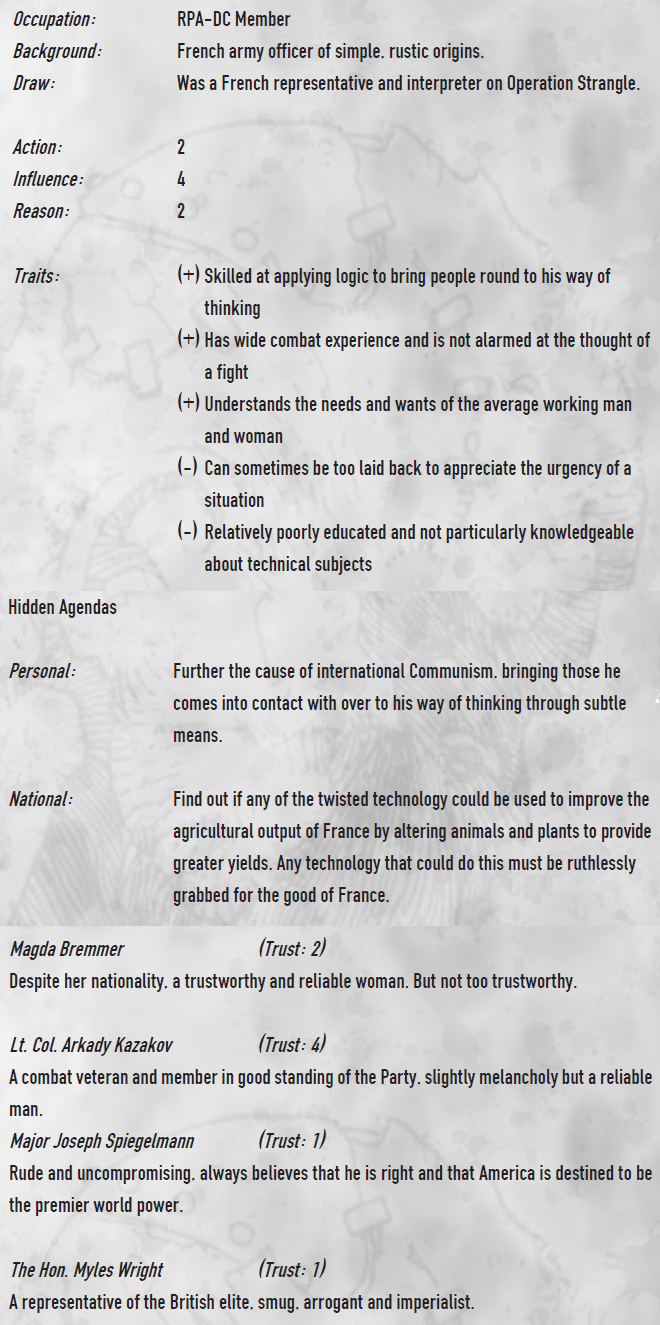
Lt. Col. Arkady Kazakov: Arkady is an officer from the Red Army put in a position he hates. He takes orders from the MGB and his main job is to pass intelligence and information back to them. To that end, he carries around a briefcase that is actually a recorder and will try to wheedle snippets of information out of people. There's not much to Arkady; he's a military man, he's not much of a political person and he ignores any questions he doesn't want to answer. He didn't want to do any of this, but he's not about to rock the boat by not doing his job.
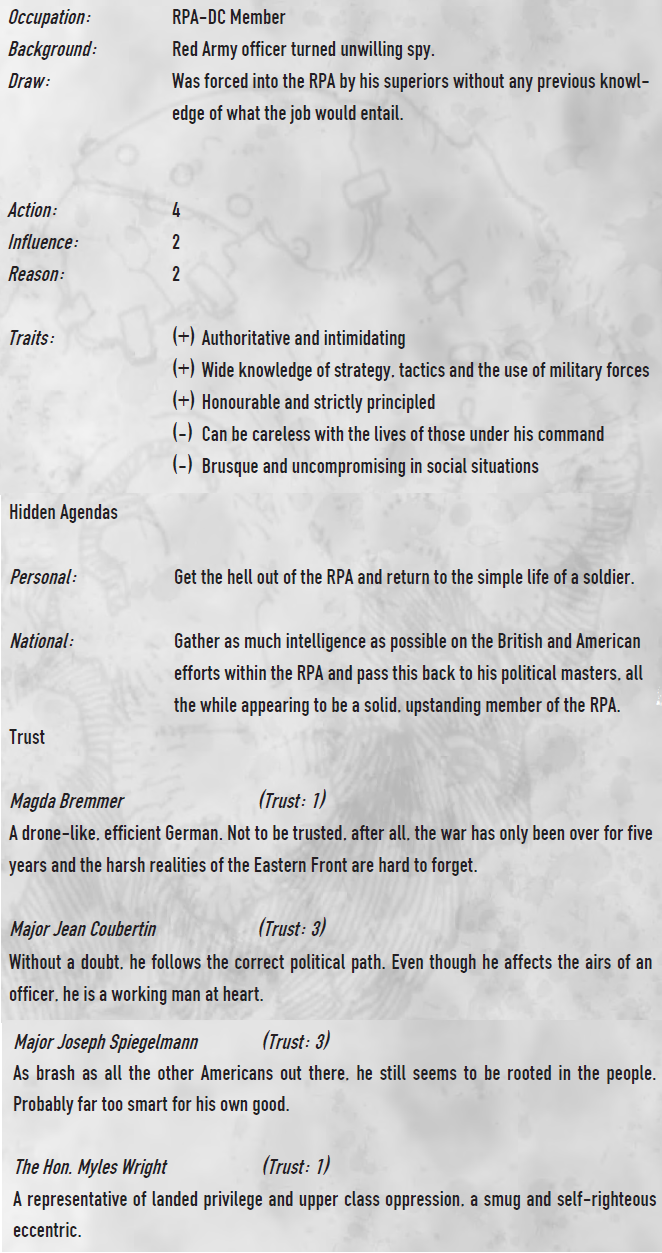
Major Joseph Spiegelmann: Joseph represents the USA, a signals officer for the Marines who served in the Pacific theater. Joseph graduated from MIT with a degree in Electrical Engineering. As a result, he's the most technical of all of the representatives. He was chosen for the job because he had no personal stake or experience in the Eastern front but as a result people are confused by his election, thinking he's too far removed. His main job is to probe Twisted Technology to uncover secrets.
Joseph is a man of bias. He's biased against the Germans because of what he knows about Twisted Technology and the experiments and genocide at the heart of the Third Reich. He's polite but distant to the French and British. To Americans and Russians, he's friendly and jovial. This confuses Soviet spies, thinking he's up to something. The main reason he's friend is because Joseph has secret socialist leanings; he's not a Communist but he does support a few of their ideas.
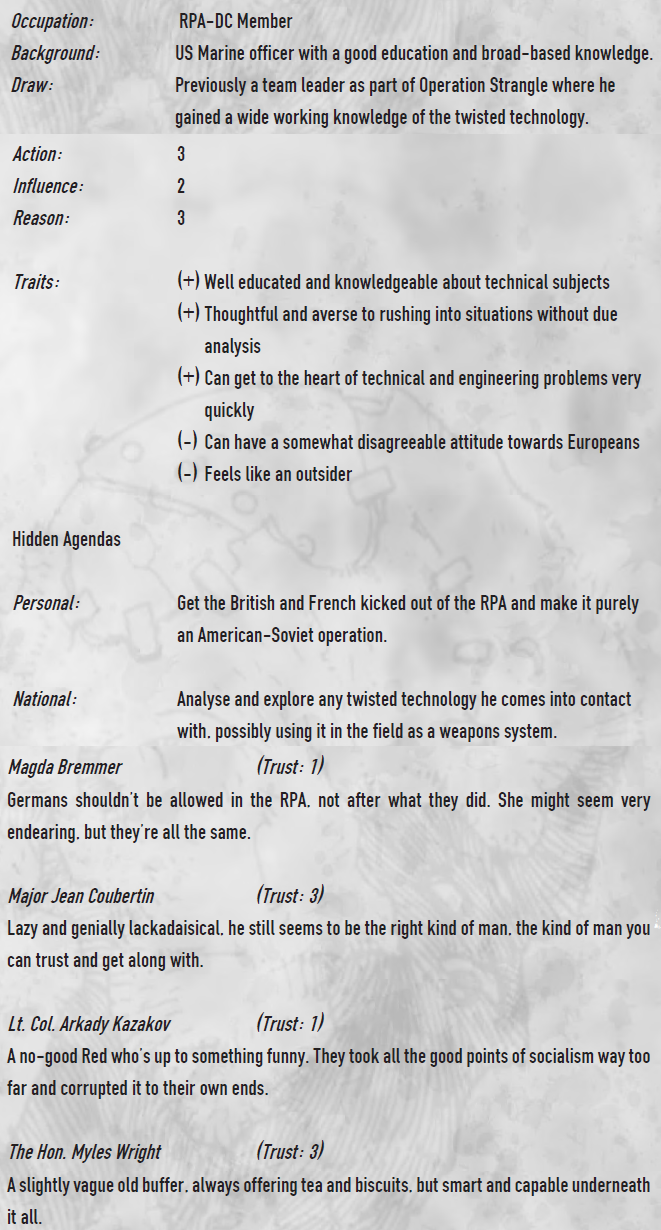
The Honorable Myles Wright: Myles is British as all hell. He loves to smoke, he wears a monocle and tweed and many people view him as a bumbling upper crust type. Myles is fine with letting people feel this way; in actuality he was a paratrooper that dropped a few times into France to help train the Resistance and that cunning and tenacity still remains. As a result he cultivates this image by nipping at drinks and telling rambling stories. In essence, he is frustratingly British.
Myles' main job is to get Britain out of Germany to help save money. All of the cloak and dagger skullduggery is a financial drain on Britain's recovering economy. The British government doesn't care if all loose ends are tied up, they just want the job completed and the RPA disbanded. This is a job Myles is more than willing to do.
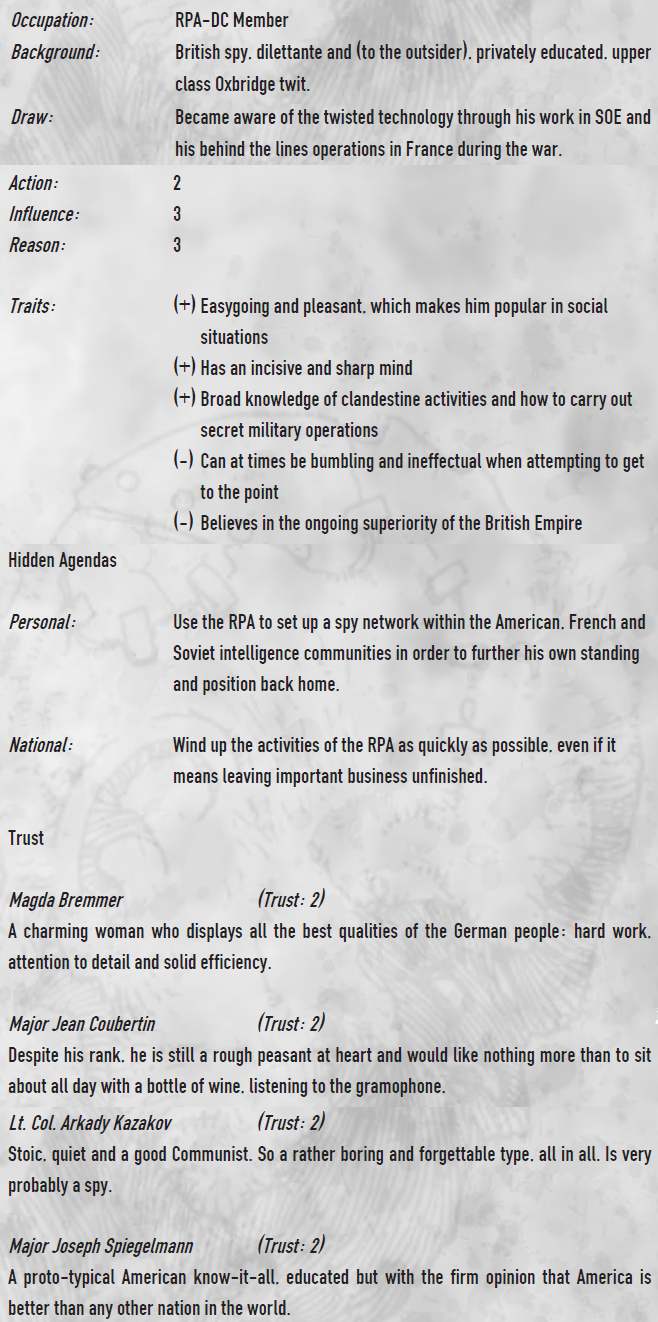
CREATURES AND EXPERIMENTS
This is not a comprehensive list of enemies created by Twisted Technology, these are just some examples. It's not hard to design your own monster or enemy.
The Alternatives
The Alternatives were Germany's attempt to create supermen. Despite being technical successes on paper, they were terrible failures in execution. The Alternatives draw from a wide pool: scientists who got too invested in the ritual, volunteered Heer soldiers, camp prisoners, political dissidents. The Alternatives are no longer completely human. Some aspect of their transformation has sundered their minds and souls, creating pitiful survivors with mental disorders and scars that will never heal. There are some who try to slip back into society, but there's a disconnect now, especially amongst the ones who ended up more monstrous than the rest.
Die Hollenhunde: The Hellhounds were an attempt to weaponize animals and create unstoppable fighters from the toughest and biggest dogs. Their teeth were removed and replaced with solid steel fangs and the rest of their body was tortured with drugs, training and pain. Why did they never see battle? Well, when you take an animal, torture it ceaselessly and augment it, it doesn't like to be controlled and it won't listen to orders. When the war wound down, the Hellhounds were destroyed or simply released to fend for themselves. There are only a few in Berlin, hiding during the day and hunting at night, but they're very hard to kill or stop. The big advantage over them is that they're animals and that there aren't many of them. They don't seem to be interested in breeding, just hunting and killing.
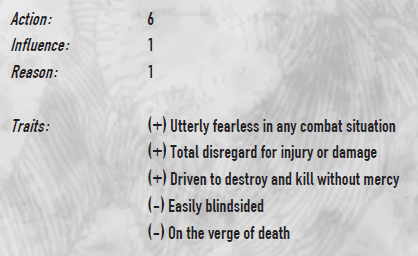
Die Nachwachter: The Night Watchmen were an attempt to create soldiers that could operate in perfect darkness. Superficially, they're human from the neck down. Their heads have unnaturally large eyes, concave ears and large mouths. These changes have given them amazing night vision and echolocation, turning them into peerless night hunters. The big downside? Insane light sensitivity and an aversion to loud noises; their ear canals were augmented to basically shut and muffle offending sounds but it wasn't perfect. The noise aversion and inability to withstand sunlight lead to the Nazis scrapping the project and the remaining Night Watchmen live underground, eating vermin and food they can scavenge. Most Night Watchmen are still capable of thought and reasoning and they hate their lives. Night Watchmen are good for pitiable humanoid enemies that may require a measure of sympathy and thinking past your orders.
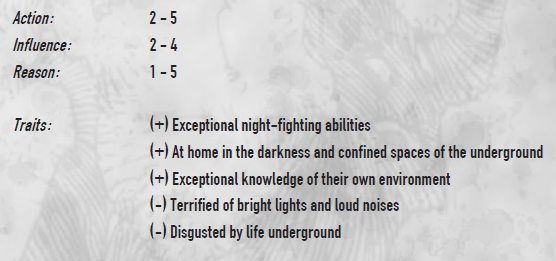
The Incursors
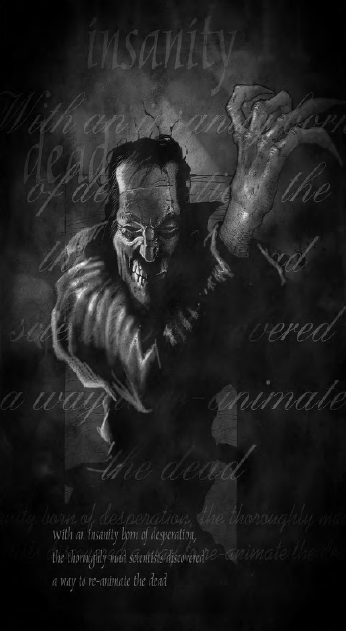
Profile of a ST. The text reads "with an insanity born of desperation, the thoroughly mad scientists discovered a way to re-animate the dead".
The Incursors were brought to our world by terrible machines that tore holes in space or simply plucked things from other realms. The machines are off or destroyed, but the Incursors remain. Some of them no longer require machines, some of them are just trapped. There's a fear that the barrier between realities has been permanently cracked and that other things can come through, things that were never brought over by the Nazis or invited. Incursors have no sort of uniformity and tend to be solitary; they may not even be capable of thought by human standards.
Der Musikant: The Music Maker is a floating, shimmering sphere with a surface that ripples with spikes and protrusions. It's accompanied by a sort of otherworldly singing that is the crux of its power. Everyone responds differently to hearing its wordless song: catatonia, madness, peaceful sleep. It was originally captured and a machine was jury-rigged to try and send it back to where it came from. But the team that sent it away disappeared after retirement, and there's strange music that still comes from the U-Bahn. It's unclear if there's another Music Maker or if it didn't work, but either way there are reports of people going out at night and being found comatose in the streets the next morning.
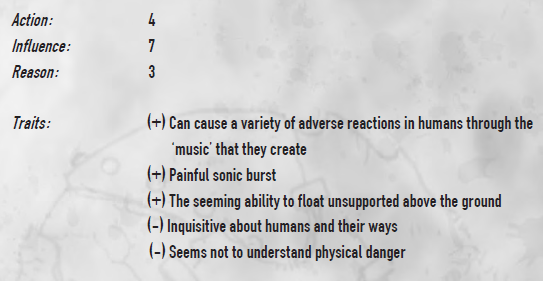
Der Weber: The Weaver is a living collection of legs and feelers trailed by skin and hair. The Weaver doesn't seem to have any sort of human intelligence, behaving like an animal that only targets things that enter its environment. What the Weaver does is, well, weave: it takes humans, trash, animals and "sculpts" them in a fatal process that binds the components together and creates "statutes". The RPA knows about the Weaver mostly because they haven't been able to injure or subdue it yet. A curious result of their attacks has been that the Weaver is actually somewhat afraid of RPA agents, always fleeing when cornered.
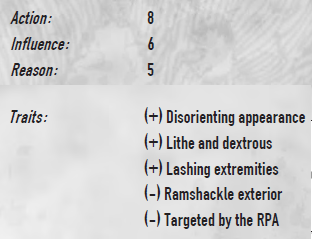
The STs
The STs differ from the other entities in that they're all uniform. The Dead are made from corpses put on a slab, pumped with volatile liquids that preserve the flesh and help keep the body together and finally a collection of electrodes is inserted into the base of the skull to shock the body back to life. They're hardy in a fight...but they're not particularly fast or smart. The Dead were actually fielded near the end of the war, sent to fight the Russians on the Eastern front and lead by SS Officers trained to handle them. It failed miserably; the Russian firepower was indiscriminate and numerous enough to blast a corpse to bits like a living soldier. Most Russian soldiers have no idea what was downwind from the firing lines.
The STs remain, but their reanimation treatment only last so long. They're rotting in the sewers and undergrounds of Berlin; the less intelligent are drawn to old military installations and the more intelligent are horrified of what they've become and hide. They die for good once they rot to the bone or their electrodes fail, whichever comes first.
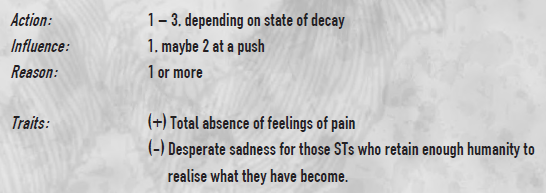
BEYOND BERLIN
Krasnoyarsk-14: K-14 has no official name as a closed city, simply named for its location in Siberia (14th district of the Krasnoyarsk area, it's a postal code). Projekt-303 has made K-14 the biggest depository for Twisted Technology on the Eurasian continent, possibly the whole word. GK-11 controls K-14 and not even other Soviet intelligence groups are allowed inside thanks to their ties to Stalin. The facility is an enormous lure for the intelligence communities of the world; the frozen city is surrounded by electrified fences, minefields, barbed wire and surveillance towers, the city's power plant is massive for the city's size and occasionally there are seismic readings that are picked up emanating from the area.
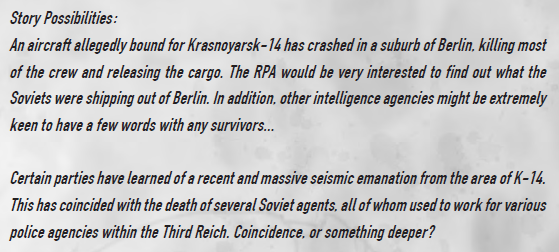
Montauk/Camp Hero: Montauk Air Force Station/Camp Hero is located in Long Island, New York. It served as a coastal defense station in both World Wars and officially it's been shut down and sealed. Unofficially, the US Navy brings researchers, personnel and equipment in by submarine to keep up the illusion of abandonment as the American government researches Twisted Technology. There's a lot of rumors about what goes on at Montauk: brainwashing, surgical techniques, generating strange new forms of energy to be harnessed. The biggest project at Montauk is researching the means by which the machines called forth the Incursors and this program gets precedence.
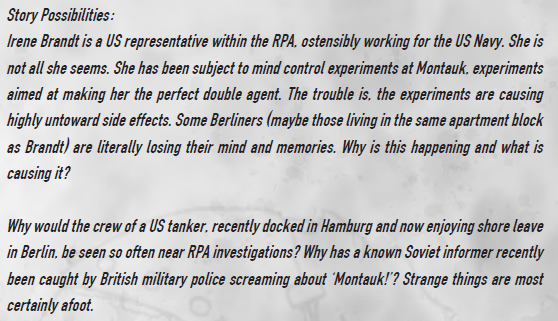
Natzweiler-Struthof: Previously mentioned, NS is located in the Vosges Mountains between France and Germany. The concentration camp was controlled by the Ahnenerbe, Heinrich Himmler's "research society" dedicated to the archaeological exploration of a master race that never existed. Eventually, the Ahnenerbe became as bloodthirsty and cruel as the rest of the Nazis. Their activities at NS were geared towards supplementary ST research. It took specific chemicals to make STs and those required giant chemical plants, but what if they could turn a living person into mind-wiped killing machine? The goal was to break people into living robots that knew no fear or pain and could be turned into sleeper agent weapons of terror, but the Nazis failed. Unfortunately, the French have looked into the research left in their backyard by their tormentors and a group of the military have started the experiments again (this time on POWs and SS captives). The main purpose of continuing is for medical purposes, but...
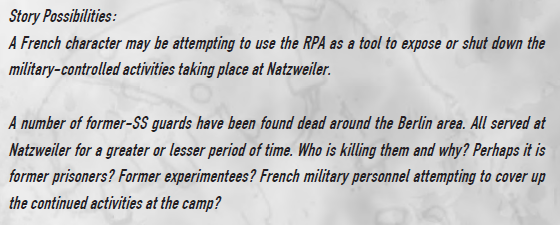
Ohrdruf: Ohrdruf was the first concentration camp liberated by American forces. Eisenhower himself (a general at the time) visited the camp to inspect the atrocities. As it turned out, Ohrdruf was connected to a nearby valley via underground tunnels. Within those tunnels, the US Army found an underground vault with an intact lab whose sole purpose was to create Alternatives; this same camp was used to create the Night Watchmen. The entire area is under Russian control now and the camp's tunnels have been sealed or destroyed. But Russia refuses to let people into the area, and there are still rumors of explosions and nuclear weapons testing. Who knows if there is anything left in the sealed facility?
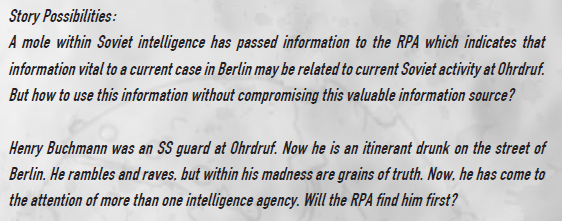
Ploesti: Located in Romania, Ploesti supplied Germany with plenty of oil and diesel for Nazi vehicles. The refinement facilities were also perfect for creating the chemicals used to animate the STs and they sent tankers full of chemicals in addition to the oil. However, through sheer luck on the Allies' parts, the bombing campaigns of Operation Tidal Wave resulted in the destruction of the creation tanks. The facilities could be repaired, but their stocks of volatile chemicals were destroyed. So the Nazis were forced to send their reserves to the Eastern front, thinking they needed the STs more than they would to fight in the west. This lucky break lead to the invasion forces of the west never running up against the STs and accidentally crippling production of their enemy's experimental weapons. But now Romania is Communist and quite friendly with the USSR, and GK-11 has infiltrated the refinement plants through advising the Romanian government. The chemicals are being produced once more.
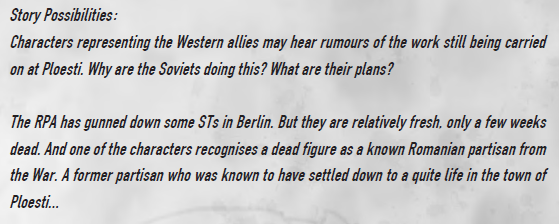
Porton Down: Previously mentioned, Porton Down is controlled by the BERB in England. Already in use for rocket experimentation, a new bunker wing was added to contain Britain's stash of Twisted Technology. And unfortunately, some of the researchers have gone a bit native in their experimentation and research. The site is completely sealed and insular, making things very uneasy through the members of the BERB as they try to do their job without delving too deep. If anything gets out, Britain's reputation abroad and locally could be irreversibly tarnished.
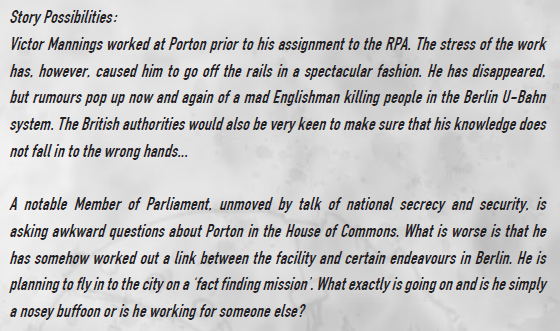
I really like the premade groups and the NPCs; a lot of them feel organic or useful for hooks and play. Reading this book has actually taught me a bit more than I knew about Germany after World War II. It does suffer a bit from "everyone is doing bad things!" but I really do like that the USSR's efforts are hindered by awful infighting and there's a strong moral center to France that is just like "nope, break it all". I'm willing to ultimately forgive it because the other countries weren't there for the creation process, they've stumbled in after the fact and are poking things they don't understand that could do something important. It's just that as the readers, we're privy to knowing the truth.
NEXT TIME: Chapter 4-2, the five premade missions and probably chapter 5, the appendices.
CHAPTER FOUR, PART TWO
Original SA post
CHAPTER FOUR, PART TWO
Sample Game Situations
There are five premade games that are bare bones and come in different tones. Most of these scenarios don’t have easy answers or solutions, leaving the GM and players to change things as they see fit. There are two real components to each game: what the PCs are tasked with and what’s really going on. There are also a few premade PCs without all of the Traits filled out so the players can add their own, but I won’t be including them.
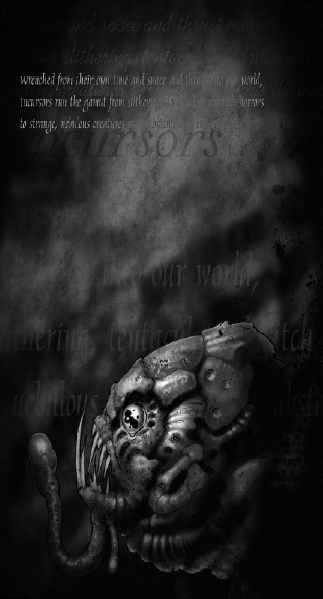
"Wrenched from their own time and space and thrown into our world, Incursors run the gamut from slithering, tentacled eldritch horrors to strange, nebulous creatures as substantial as the wind".
OPERATION VIOLINE
Tone: Dark horror.
The players are tasked with investigating a murder in the British part of Berlin. An ex-Kriegsmarine and current black market operative by the name of Hubert Ostermann was shot to death and ritualistically mutilated. The RPA believes it’s the work of an Alternative, one they haven’t seen before. In actuality, it’s the work of 15-year-old Karl Schumann.
Karl was a part of the Hitler Youth and he’s never wavered from those beliefs. His father, Hauptsturmfuhrer Schumann, disappeared near the end of the war. Karl’s older sister, Mikaila, took care of him for those five years by taking menial jobs but eventually turning to prostitution. Karl would play piano for tips at the brothels and bars near the bases. And then one day Karl started hearing his father’s voice in his dreams. The elder Schumann was involved in experiments with scientists of the Reich and they had all fled through an Incursor machine altered to let them through. The machine was part of an emergency defense system in case Germany lost the war and Schumann and the scientists are stuck in a German fortress on a dead alien planet. Karl is their ticket to returning home.
As part of his Hitler Youth training, Karl was trained in guerilla warfare in case of occupation. His dreams initially were just telling him where to find the parts to assemble the gate, then how to put the machine together. Now his father is telling him how to power the machine: by causing pain and suffering near an uncharged capacitor. Karl picked Ostermann to die after Ostermann beat Mikaila. It would have been a simple murder, but Karl has a lot of unresolved rage towards his sister, his father, his country and himself that manifested with a flurry of post-murder mutilation. And he will only continue inflicting these savageries on the people he selects to be targets, all of whom are ex-Nazis that have moved on to other careers. It’s not explicitly mentioned why they’re the ones he chooses, but it’s implied that it’s mostly because he feels they’re traitors who abandoned their Fatherland when they lost. It’s up to the PCs to get to the source of the murders and stop Karl from killing more people. But what to do with the machinery and his father?
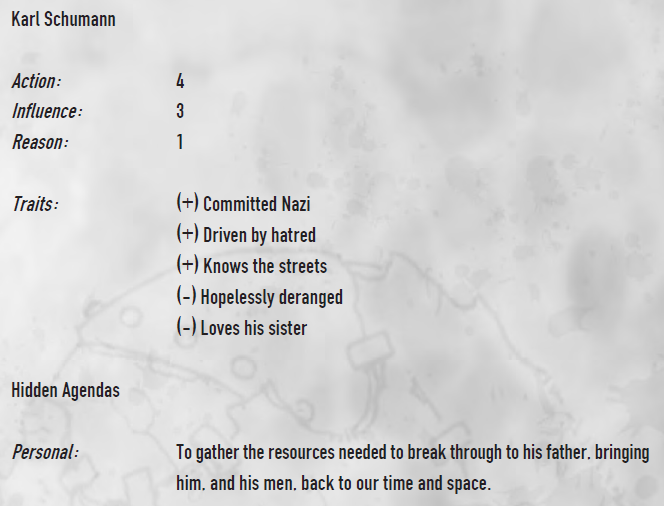
Future Victims
- Freda Galen, ex-League of German Maidens leader, now a mistress of a British officer.
- Wolfgang Gollancz, former propaganda actor turned comedian.
- Gerhard Gerber, ex-party official who now works for the coal board.
Other NPCs and Groups
- Mikaila Schumann, Karl’s sister.
- The Gehlen Org, a group of them lead by blind ex-Nazi Christoph Diehm. Diehm has no inkling of the Twisted Technology angle; he simply believes that the elder Schumann is still alive and in contact with his son and that the RPA are out to arrest Karl’s father. He’s trying to recruit Schumann to Gehlen Org.
- The Stasi, who will cross paths with the players once they investigate Ostermann’s apartment and may occasionally keep popping up to cause the PCs trouble.
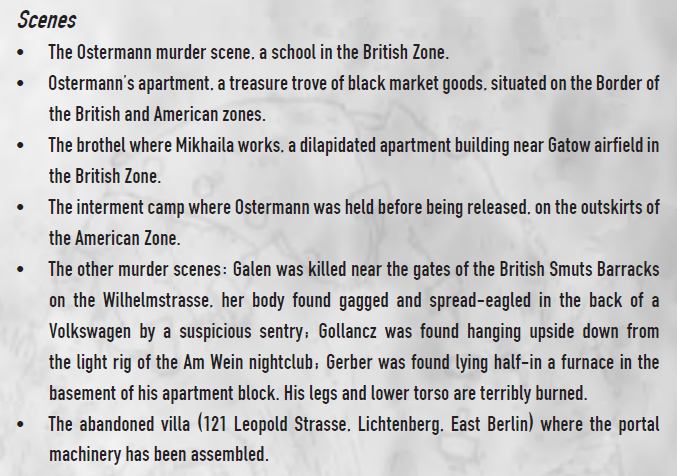
INSIDE YOU
Tone: Arthouse with elements of body horror.
Major Vernon Kite works for the RPA, a veteran of the war for the English. He’s been consigned to a desk for a while now after he was presumed to have cracked under the strain of the later years of the war. He’s a quiet man, very inoffensive and unassuming. The PCs may know him through political dealings at the office or just generally being friendly to him. They may barely know he exists, really just seeing him as a background character. He’s a nice man when you get to know him. It’s just a shame that Vernon isn’t Vernon anymore.
He was an infiltrator for the British nosing around in Germany back during the war, focusing on the Brocken base in the Harz Mountains. Brocken was built into a cave system, completely self contained and dedicated to research into Incursion machines. Nobody knows how Vernon got in; nobody knows how Vernon got out. Nobody knows that one day the thing that came through the machine implanted a piece of itself into everything alive and all the machinery in the base. The infected Vernon escaped the base and radioed British bombers to bury the entire base in bombs. It worked, but over time the infection within his body ate away at his mind and soul.
Vernon Kite exists only as a body now, his mind and soul consumed by a piece of the Incursor that lives on the other side of the veil. Now that it has complete control, the puppet master is using Vernon’s body to create a new portal to bring the rest of the body through and make itself whole again. Now things are starting to go missing and people are starting to get hurt, all part of the plan to build the gate. It might not be hard to stop Vernon, he’s only one man. The problem is figuring out who is to blame to begin with and if Vernon could be disconnected from the Incursor.
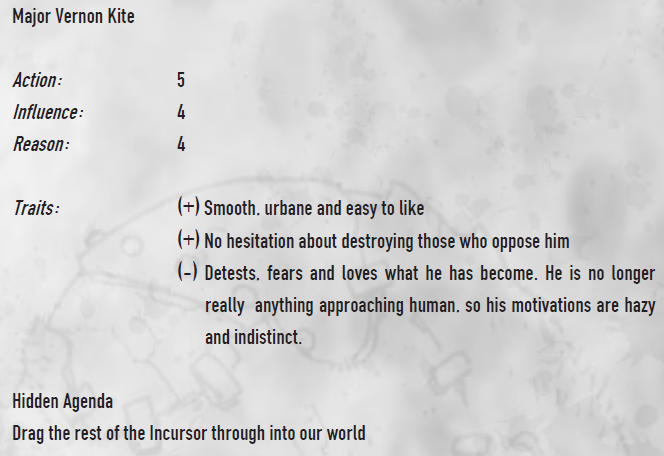
Other NPCs and Groups
- Corporal Keith Bramley, his batman. Keith knows there’s something up with his superior but he thinks it’s a simple matter of Vernon being turned into a mole for the Soviets. He hasn’t told anyone of his suspicions because Vernon is aware Keith has been stealing supplies but keeping it quiet.
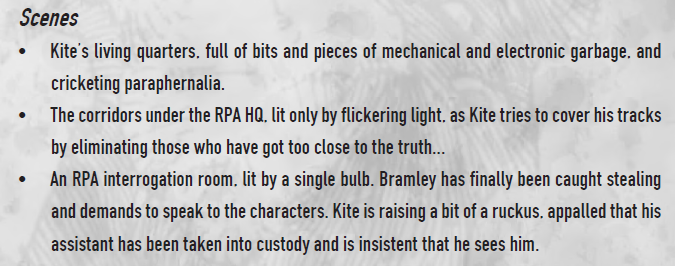
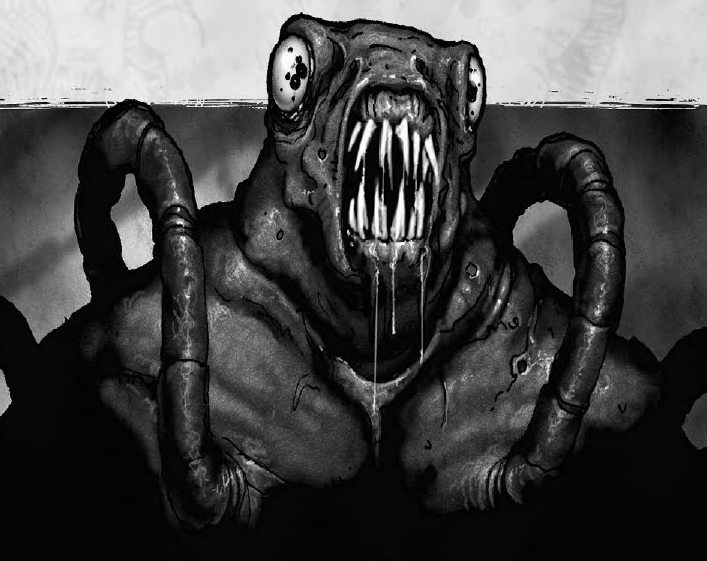
OUR MAN IN BERLIN
Tone: Black comedy.
The PCs have to escort a member of British Parliament around Berlin. The MP, one Bert Stanshall, has gotten suspicious about the ties between Porton Down and the RPA. He has no idea what’s going on and the higher ups of the RPA want to keep it that way. Not helping things is that Stanshall is an oafish, blustering knucklehead with a middle class view of the world and a dislike of foreigners and “welfare parasites”. The crux of the mission is to bring Stanshall around on mundane things like busting smugglers and raiding clubs while keeping him away from the more supernatural, top secret elements. The plan is to make him think that the RPA is a boring police organization. Also along for the ride is General Brian Robertson, High Commissioner for the British Zone who is leading a security detail of soldiers protecting the MP. Complicating things is the fact that Stanshall is often looking for trouble, poking his nose where it doesn’t belong and blundering his way into things. He’s convinced that the Labor government is funding nefarious things and finding any proof will help his political career.
And then someone tries to kill him.
The SIS is the main antagonist for this mission. They know that someone is feeding Stanshall info linking Porton Down and the RPA and Stanshall’s “investigating” is heavily rocking the boat in Germany and London. The spies are perfectly willing to kill him to shut him up and to this end a bunch of ex-Heer soldiers are lead by Agent Gareth Carey to carry out the assassination. Their plot is to make it look like a hit by some ex-Nazis out to stick it to the British, throwing the ex-Heers under the bus and giving the SIS an excuse to crack down in the area. Regardless of whether or not the assassination attempt succeeds, the PCs are tasked with figuring out who’s responsible so the RPA doesn’t get the blame.
Other NPCs and Groups
- Harry Vickers, Stanshall’s secretary. Vickers is a competent man and a gofer, happy to see the sights of Berlin and practice his French and British. He’s an amateur photographer and loves snapping photos when he has a chance. Unfortunately, some people might misinterpret his fluency in linguistics and his shutterbug nature as him being a very obvious spy.
- Lieutenant Colonel Farman Winstanley, General Robertson’s aide. Winstanley is supremely British, pompous and arrogant, often seen barking orders. He distrusts the RPA completely and should anything go wrong he’ll blame it on the PCs and the RPA to try and make them take accountability.
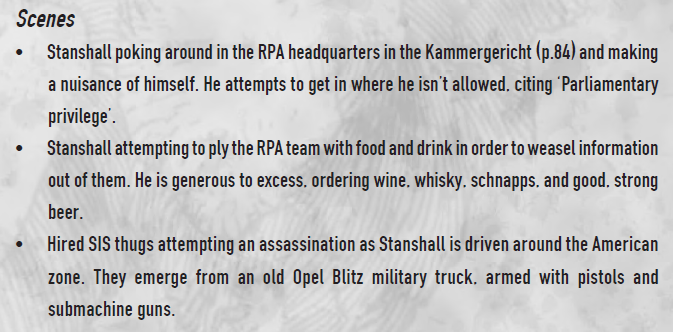
THE PRODIGAL SON
Tone: Tragedy and horror, maybe with the lightest touches of black comedy to help elevate things from being too dark.
There are rumors of STs in Charlottenburg after a young child disappeared and his clothes were found two days later. Magda Bremmer debriefs and doesn’t have much to go on besides a light outline of the mission: investigate the area, try and find the child, see if there are STs in the area and keep the public calm. The actual culprit is an American soldier named Sergeant Dan Kramer. Kramer received a head wound in the Battle of the Bulge that he managed to survive at the cost of his sanity and ability to control himself. Sometimes Kramer just gets the urge to kill and when he does, he kidnaps someone and kills them. No torture, no sexual assault, just the blind urge to take a life. The poor child is the last in a line of ten other people Kramer has killed and he just can’t stop himself.
Sergeant Kramer, however, is not the focus for this mission. Yes he’s the true culprit, but his activity is accidentally being overshadowed by Werner Diephof and his parents.
Werner is the source of the suspected ST activity. He was killed on the Eastern front in 1943 and his body was considered intact enough for reanimation. He was brought back, given a gun and sent back out into the fight against the Russians. But he survived and was still intelligent enough to figure out how to make his way back home, taking six years to shuffle his way to Charlottenburg. His parents were horrified when he showed up on their doorstep, but they quickly decided to keep him in the air raid bunker in the basement. Frau and Herr Diephof were not willing to give up their returned boy, not after their other son was killed (fighter pilot, shot down).
Werner lives in the basement. He’s no threat to anyone, spending his days in silent depression. Seriously, unless you’re wearing a Red Army uniform he won’t be any kind of threat and even then it’s just a mild tired sort of anger. His occasional moans and crying have been heard by the people of the neighborhood who have begun to whisper and gossip. The neighbors will point the investigating PCS to the Diephof household, where they will do their best to hide Werner from the PCs. Even if he’s found, they won’t resort to violence but they will do everything in their power to keep their son and convince the PCs to let him stay.
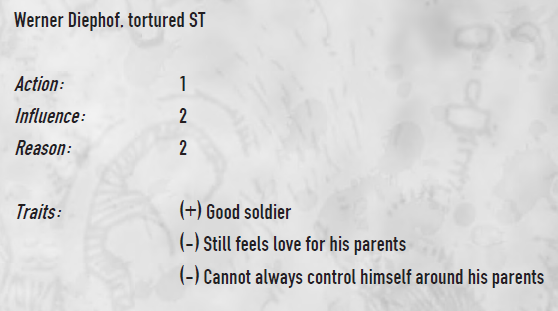
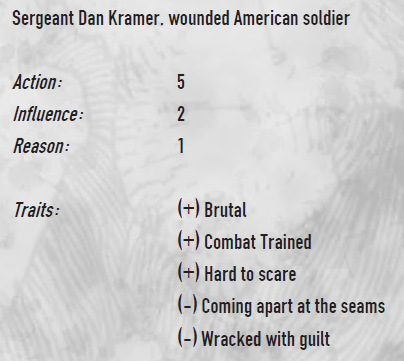
Other NPCs and Groups
- The local children, kids wearing ragged clothes and living in poverty. They can be pretty easily bribed for information.
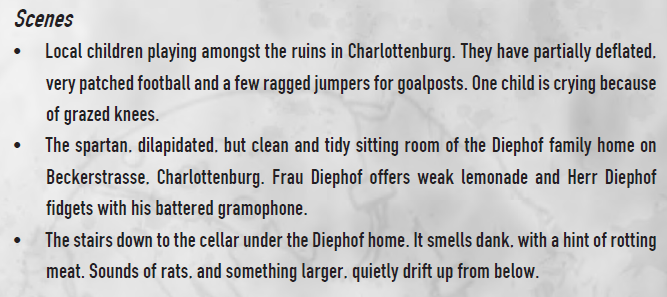
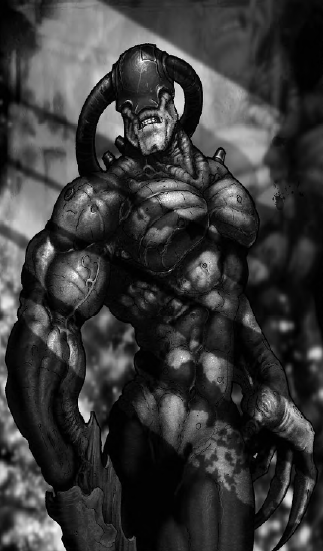
TRANSFORMATIONS
Tone: Noir with swirls of bloody horror or body horror.
Someone has been murdering members of the black market in East Berlin. Arkady Kazakov thinks that while it may look like gang warfare, there’s something else going on. The VoPos and the Stazi have been taking an interest in the killings which has only been making Kazakov’s job harder. He will tell the PCs not to rock the boat too much and assign them a VoPos officer (Heinrich Gerlach) to accompany them. Their job is to find the murderer and let Gerlach just think that the RPA is a multinational wartime police force.
Unfortunately, the murderer is an Alternative by the name of Greta Stauber. During the war she was experimented upon in an effort to create covert supersoldiers in case of enemy occupation. Whenever Greta is scared, tense or stressed, her body transforms. She gains big bulging eyes, long sharp teeth that make her mouth bleed and spurs of bone that shoot through her fingers into wicked claws. In essence, she resembles a shaved werewolf. When Greta is transformed, she can’t be reasoned with or stopped until she no longer feels she’s in danger (whereupon she will revert back to normal). The reason that these black market salesmen are dead is because Greta has been taking muscle relaxers and tranquilizers to keep her calm. She’s killed other people, but the black marketers have died because they pushed her too far in a deal or asked too many questions, causing her to inadvertently panic and transform. Then, to make things worse, there’s the matter of her six month old son. She hates herself and she hates the Nazis who did these things to her, but she’s holding on and trying to live a somewhat normal life for the sake of her son.
But the PCs are coming for her, and the drugs don’t always work at keeping her calm and relaxed.
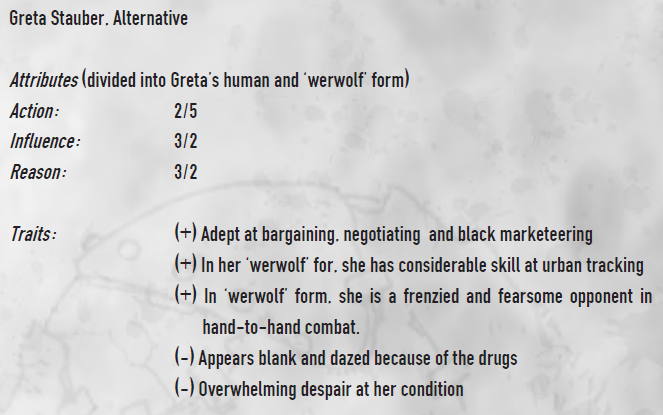
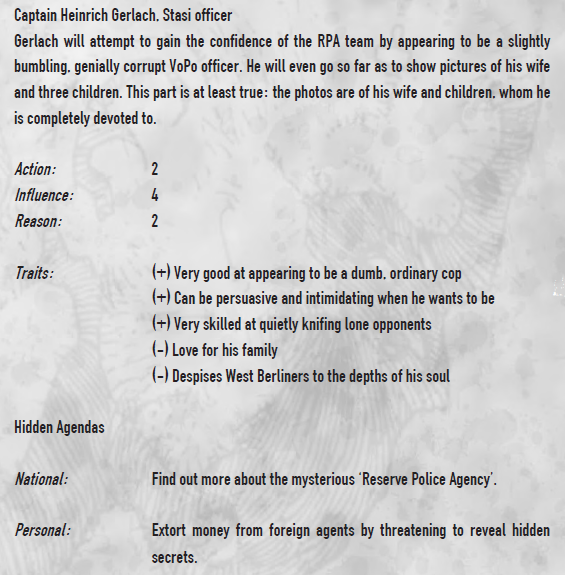
Other NPCs and Groups
- Johann Brandt, local black market kingpin. Brandt is friendly with British and American soldiers, happily taking wares from them to sell and using soldiers as muscle when he needs to. Brandt has an active bounty out on the head of the person who killed his colleagues.
- Frau Huber, Greta’s landlady. She babysits Greta’s son sometimes and think the reason Greta is acting odd is because she’s prostituting herself. But she doesn’t judge and she’s a kindly enough woman to try and look out for Greta if she can.
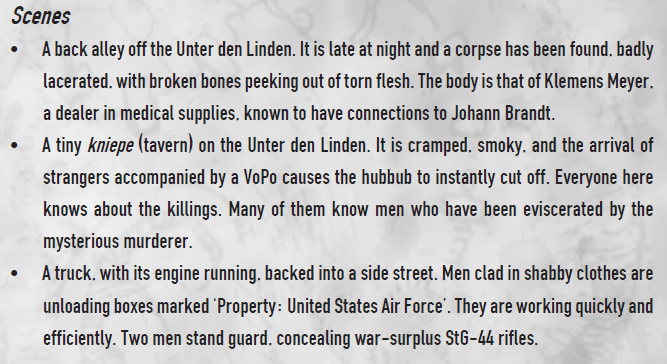
I really like these sample missions a lot! They highlight the ambiguity of the job pretty well and I like how Our Man In Berlin feels like a reskinned Paranoia mission in a good way. They’re engaging, they’re flexible frameworks to build on and they help paint a good picture of what it’s like living in a city with monsters just barely out of sight. It feels a little like Men In Black but in a good sort of way.
CHAPTER FIVE
Appendices
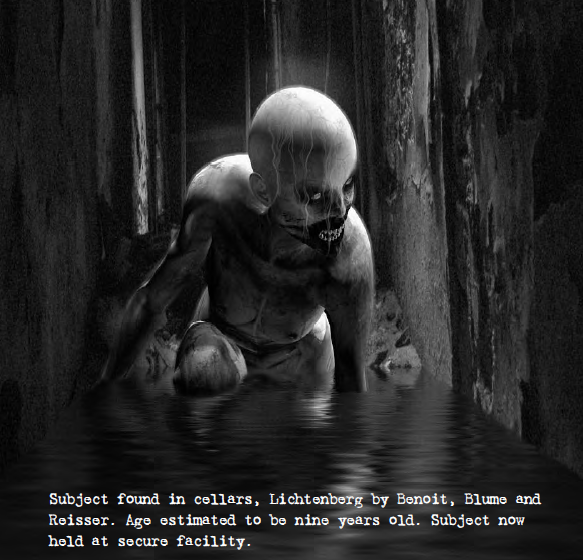
The appendices are pretty brief because the book is pretty much over. I’ll just go over their content, it’s nothing too deep.
- Appendix One: General glossary of terms, like what ST means.
- Appendix Two: A timeline of major events between 1946 and 1950. I totally forgot that by the time June 1950 rolls around, the Korean War is about to begin and that means that the USA might have to withdraw from the RPA to help South Korea.
- Appendix Three: The equipment section. Because equipment doesn’t have stats beyond use as a tool, it’s really just a loose guide of common weapons for the time period and other gear to help inspire character creation and goods. There are also common vehicles listed and a machine that lets people track STs by picking up the electricity of their electrodes at the cost of being highly temperamental to use.
- Appendix Four: Tables for generating random names for different nationalities: American, British, Dutch, French, German, Italian, Polish and Russian.
- Appendix Five: Inspirations and influences, books (fiction, nonfiction and fringe speculation), movies, videogames, websites, tabletop systems and television shows that act as sources of info or ideas for running the game.
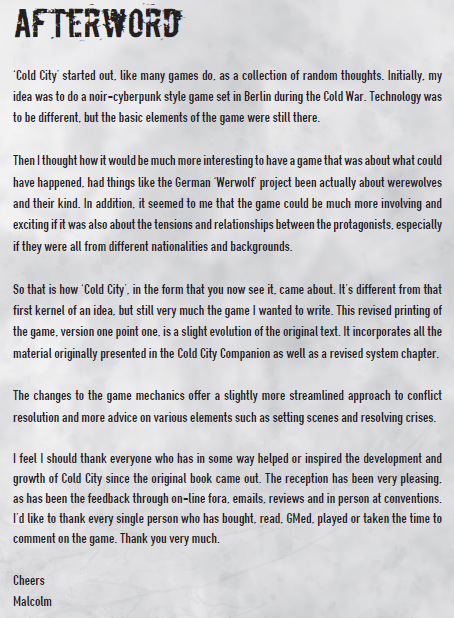
That’s it for Cold City. Again, I like it quite a lot. The setting is pretty compelling to me and I like the mechanics. They’re pretty versatile and you can easily strip out the system for a story-driven sort of game.
So there’s a sequel to Cold City. Well, not exactly. It’s more of a sister game that accompanies the plot and the story established here, prefaced with a “what if?”. You could very well have the divergence from our world end with the inglorious destruction and sabotage of all Twisted Technology. Ultimately, I think it would be a good choice if you took that route. The world had a brush with weirdness and that was it, it all went away in the long run. You could have your somewhat standard alternate history where all of this weird technology becomes commonplace or revolutionizes the world. That doesn’t really compel me nearly as much because Twisted Technology is bad. You can’t compare it to experiments in nuclear power because nobody gets tortured to death to start a reactor. The French goal of using it for agriculture is noble but laughable because at some point there’s gonna be committee hearing on whether or not the French agricultural industry should allow ritualistic flaying for better crop yield and most people sitting at that table are going to be confused and horrified. However, those are your own paths to take.
The sister game doesn’t take either of those “what if”s. The one chosen is “what if the governments of the world continue to research Twisted Technology and then it’s actually used?” I’ll see you guys in 1963 and in the shift from noir and monster hunting to horror and desperate survival.
